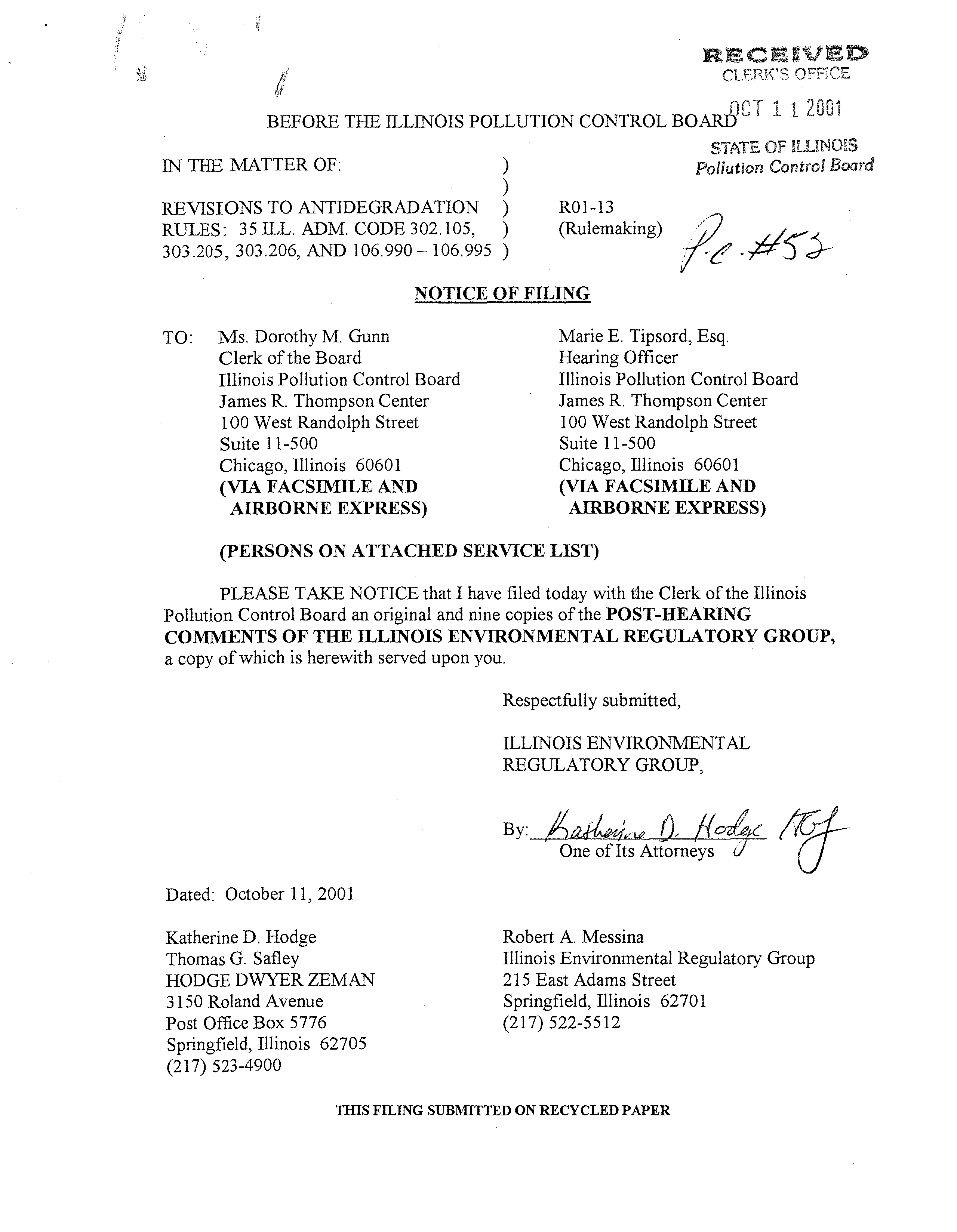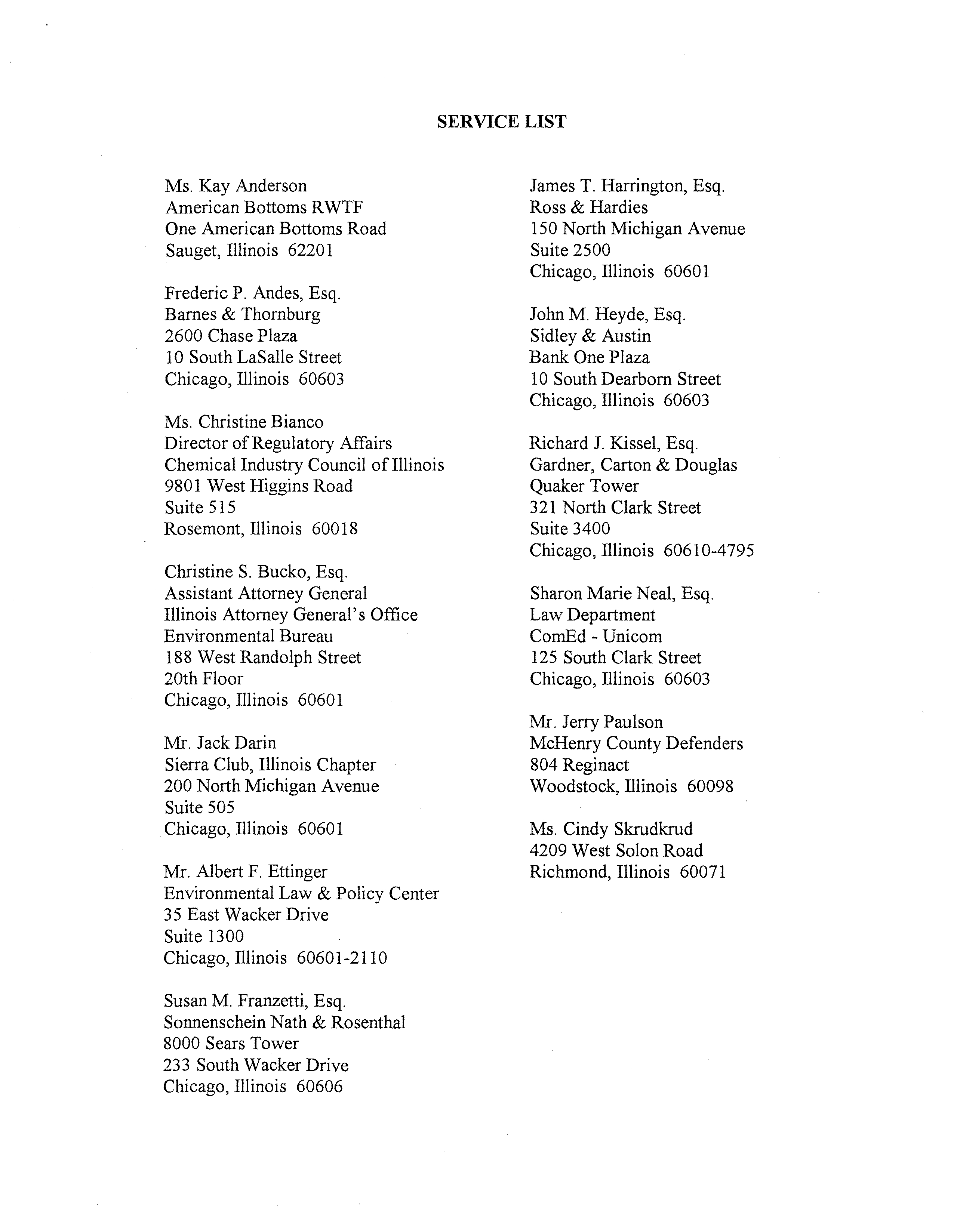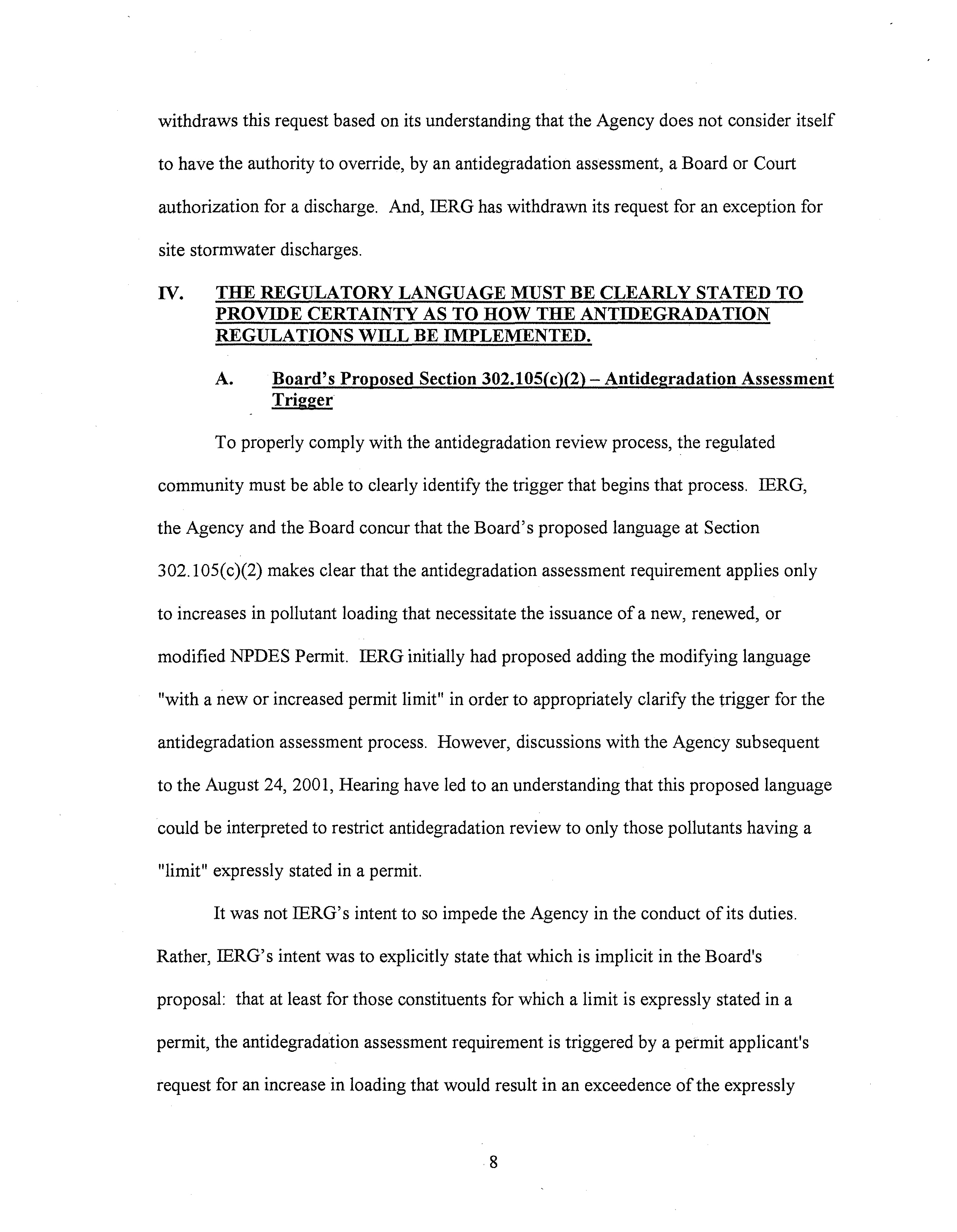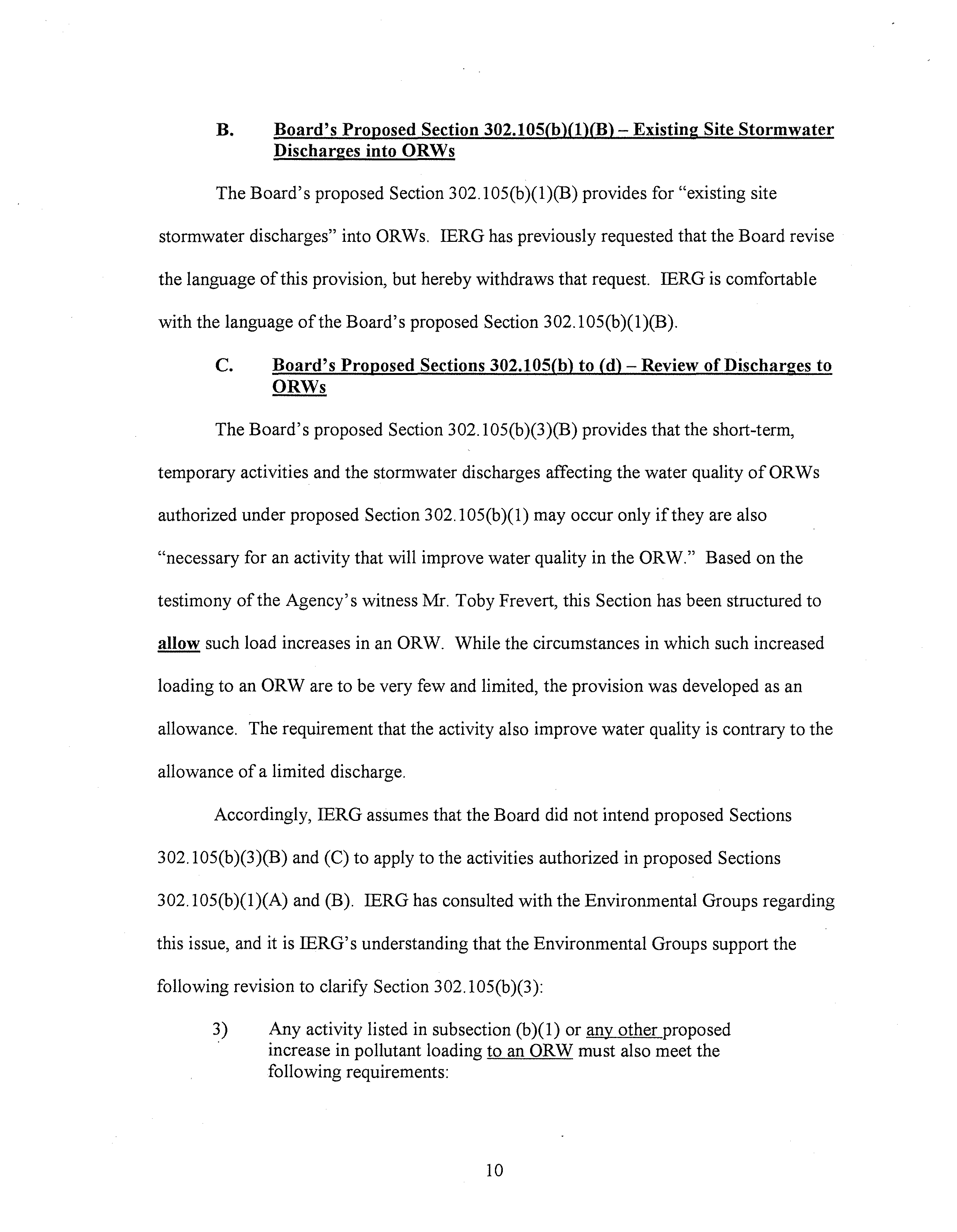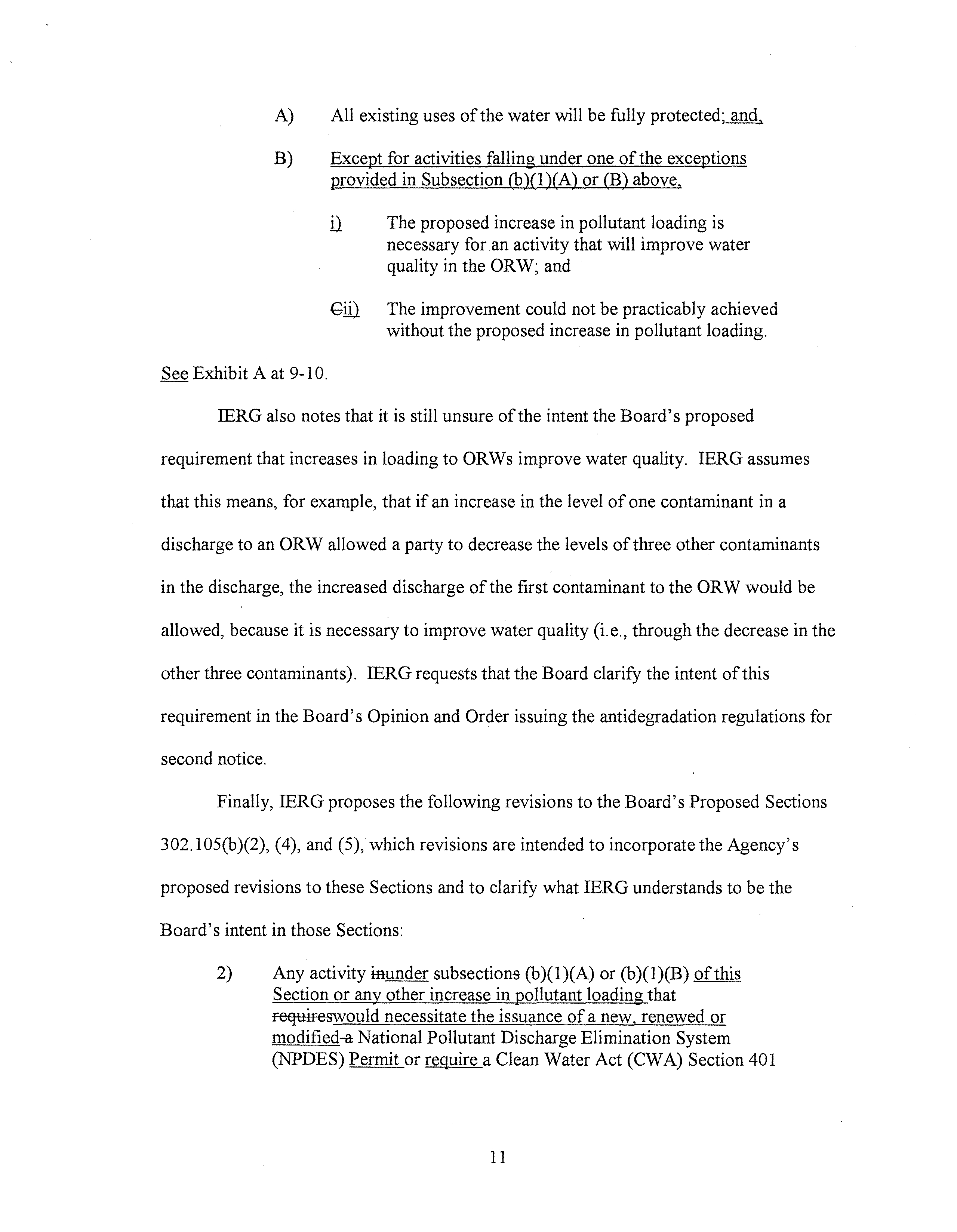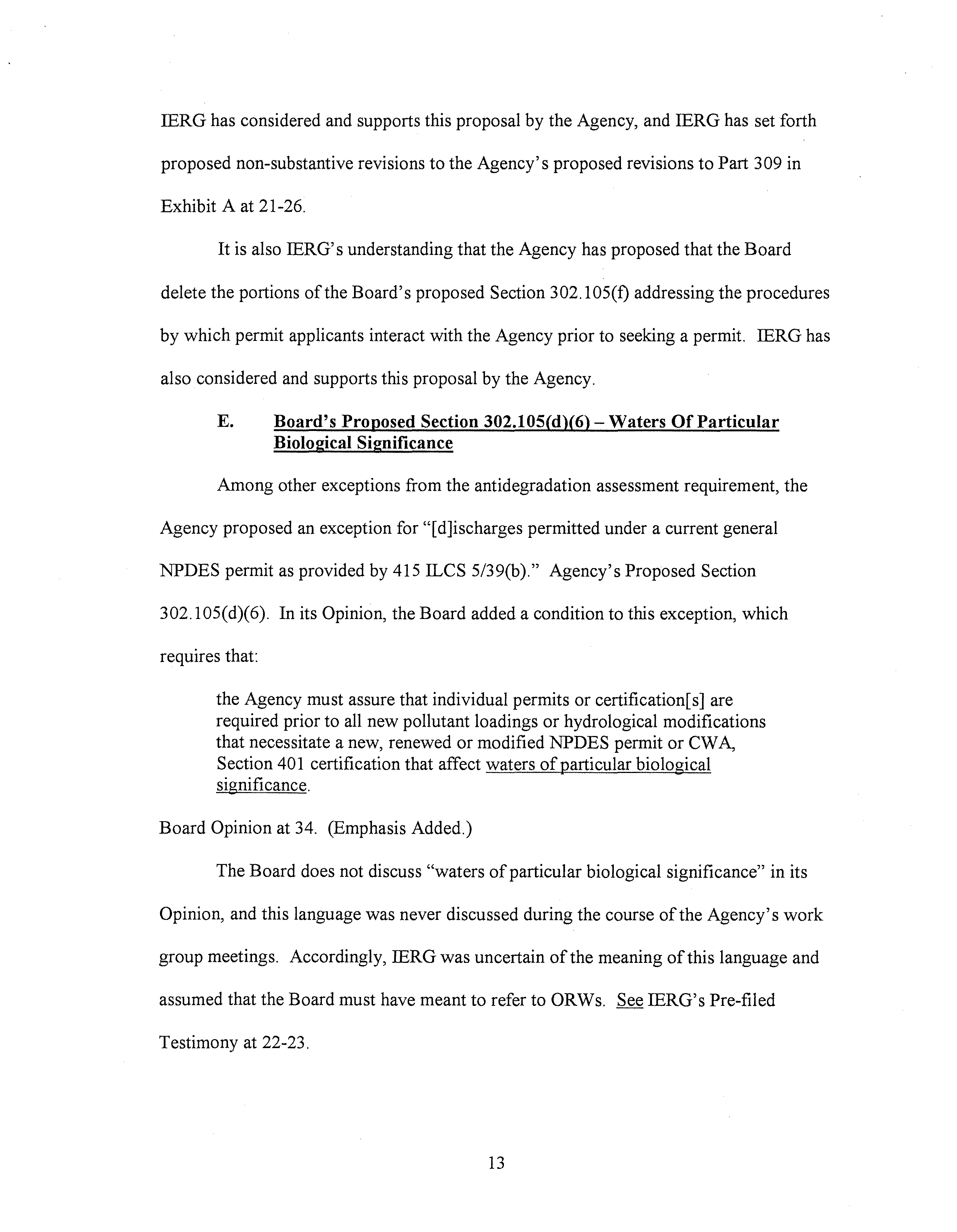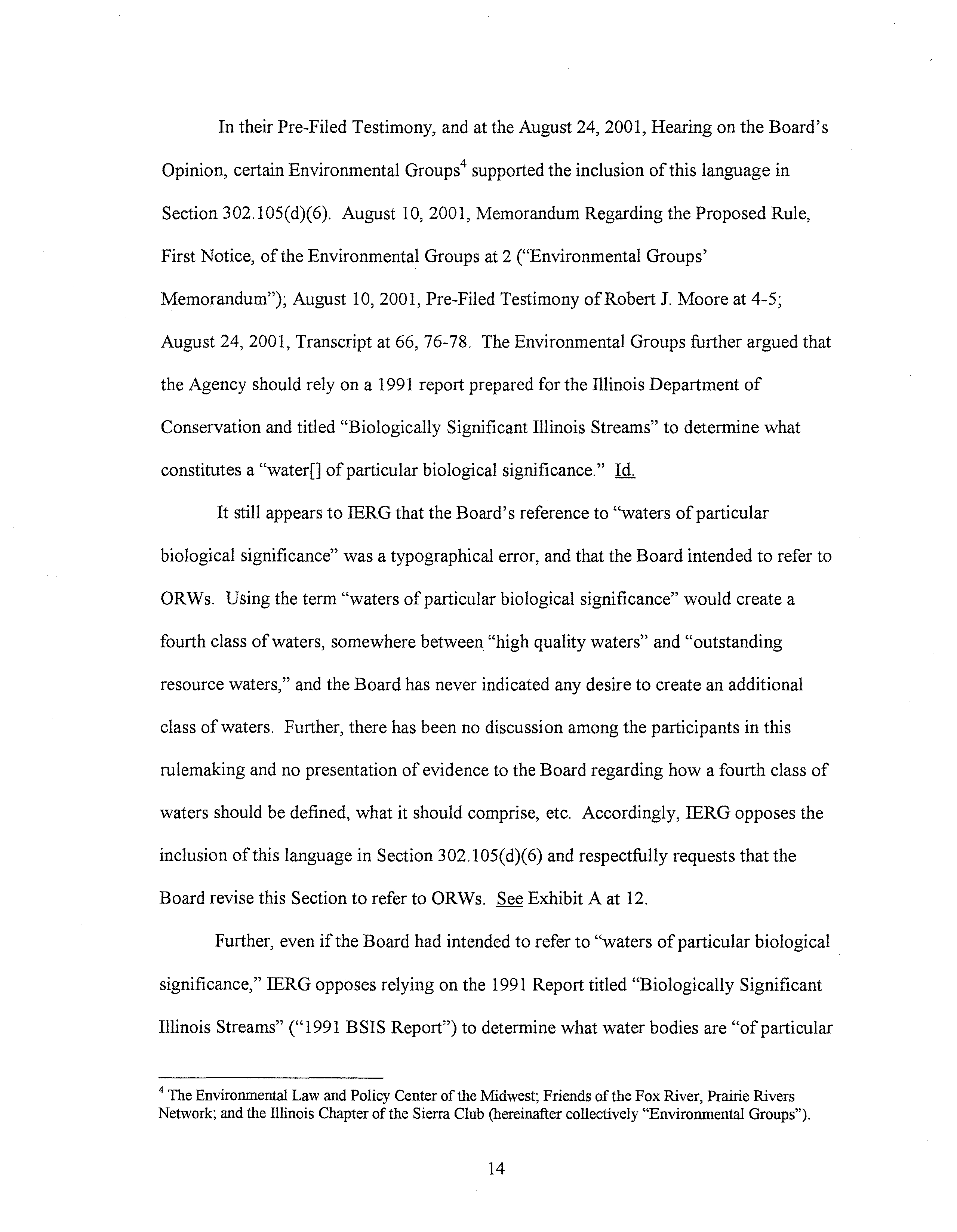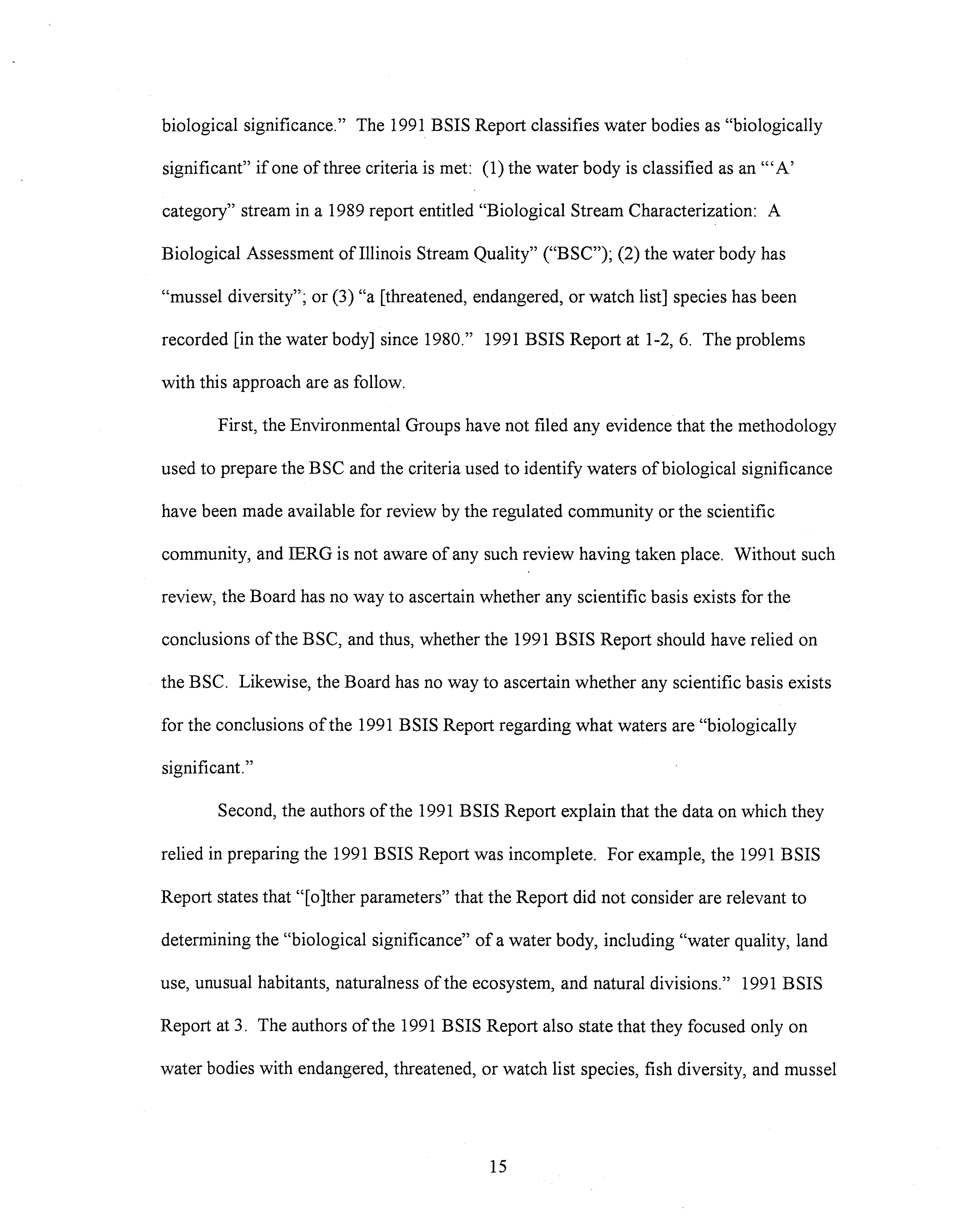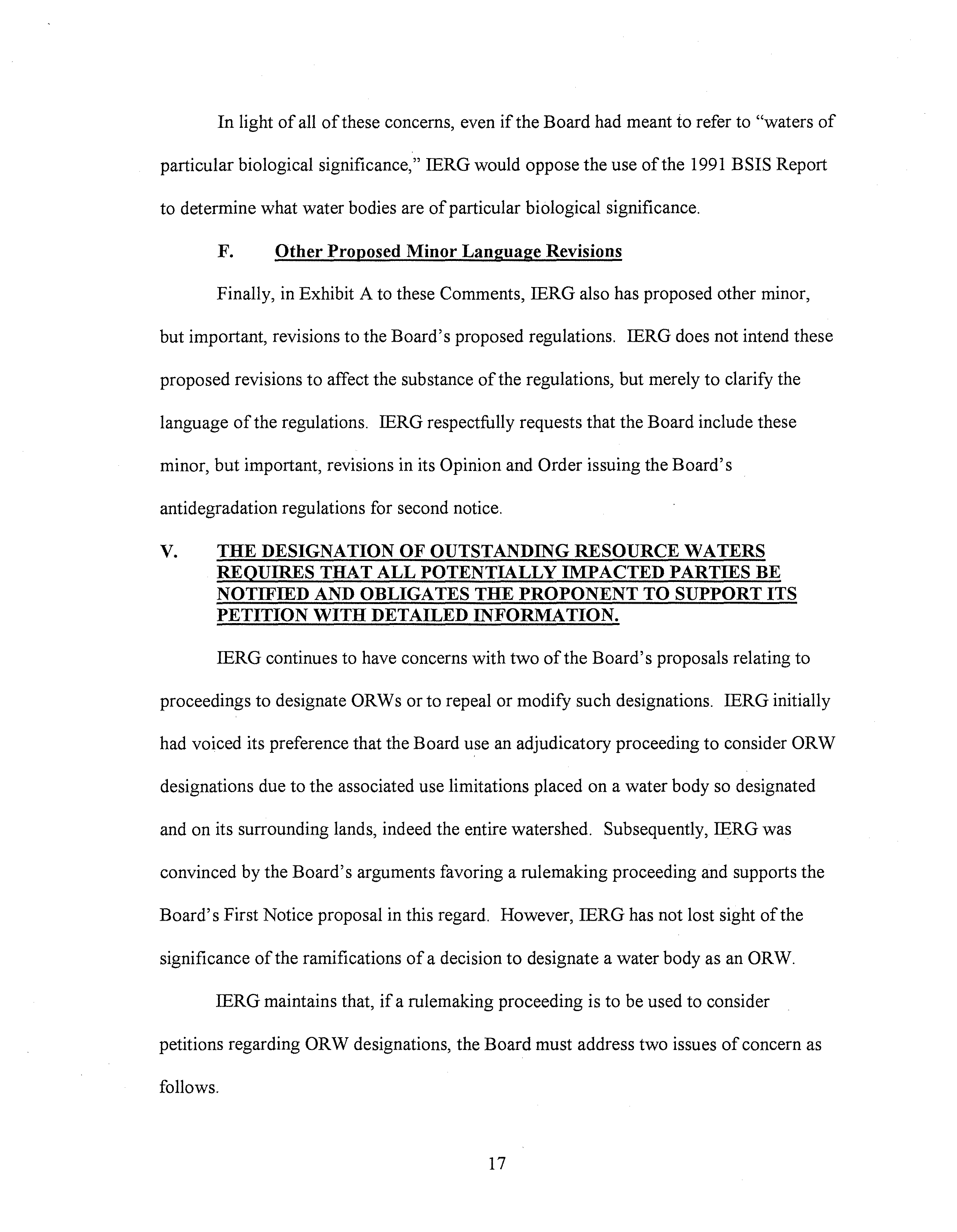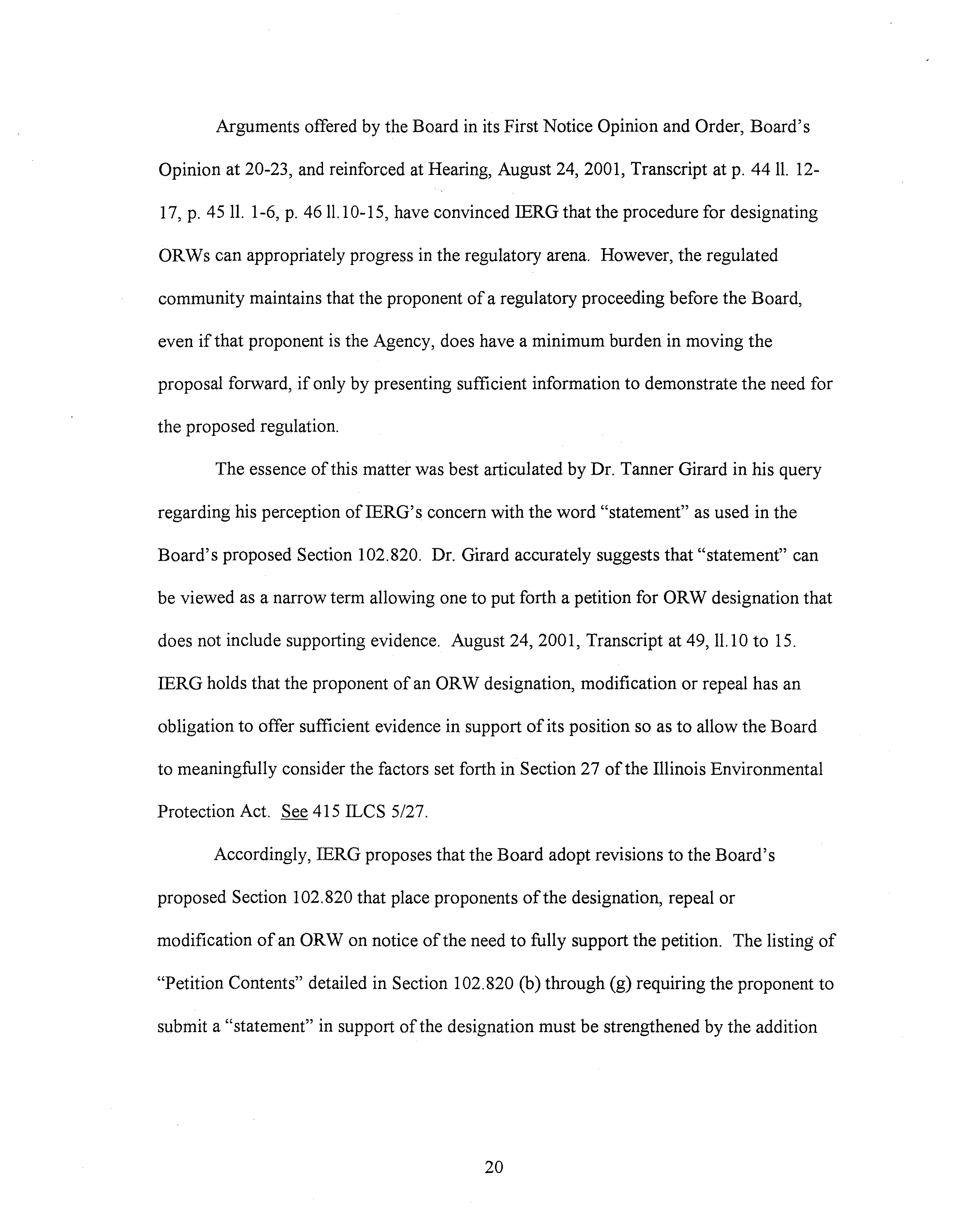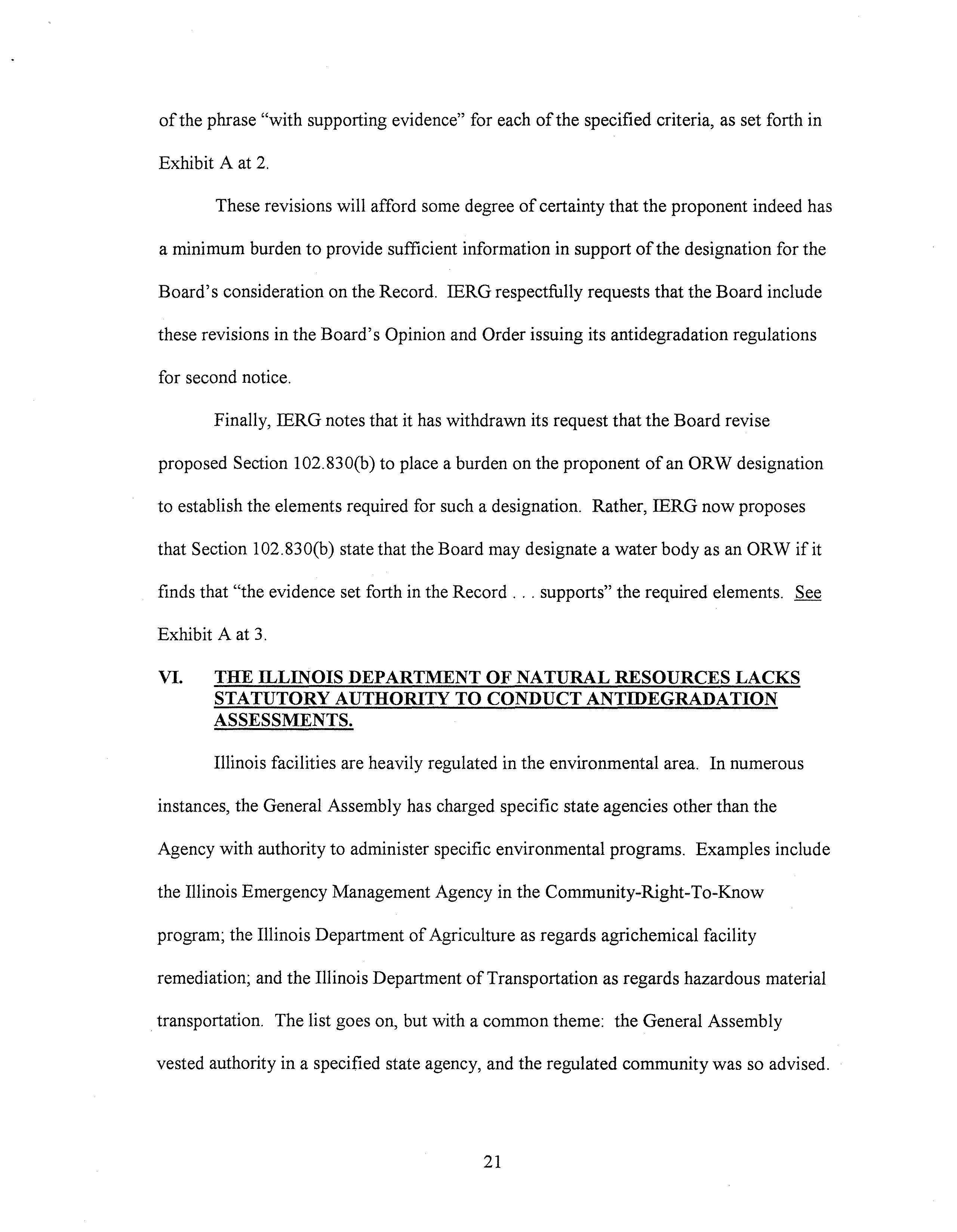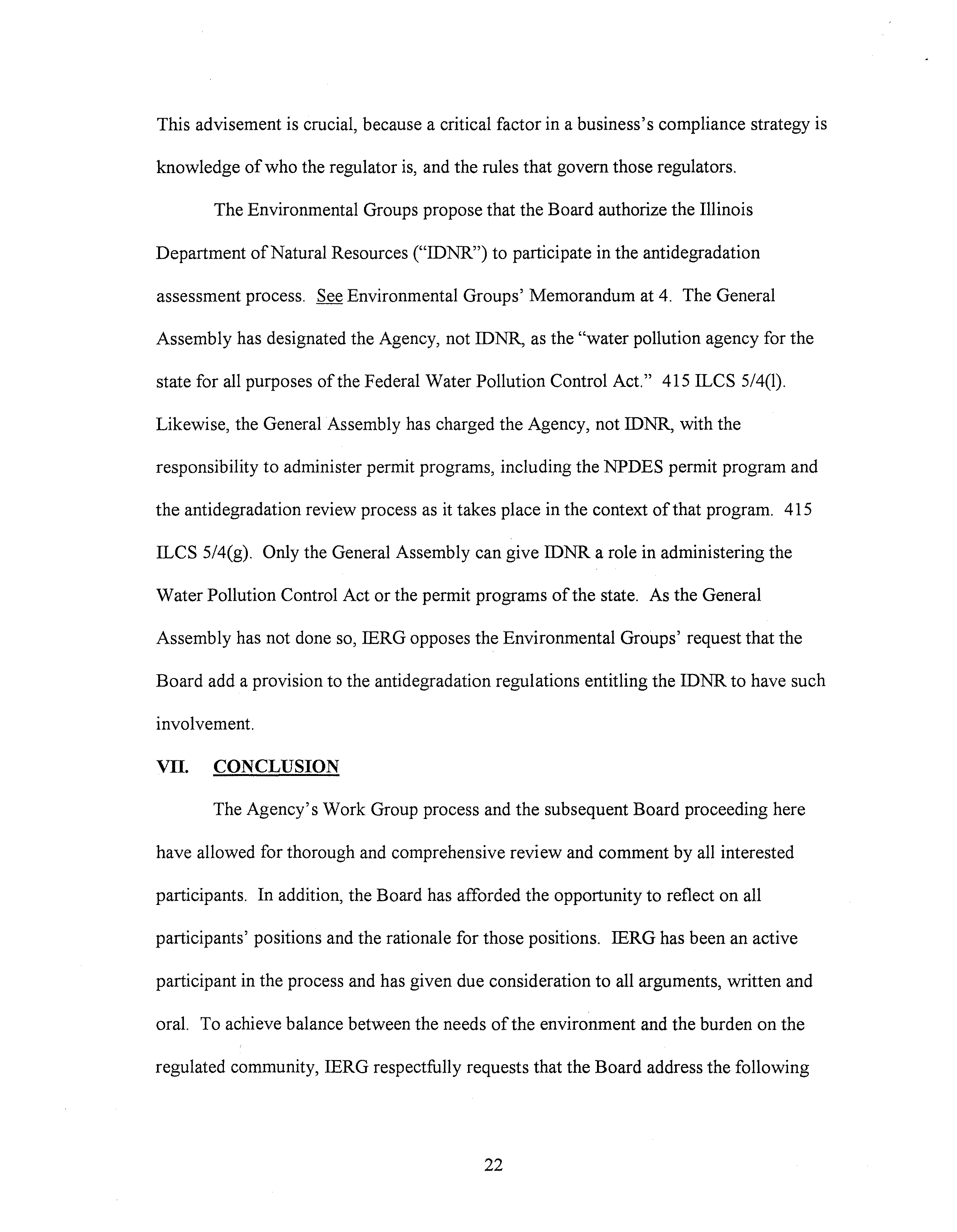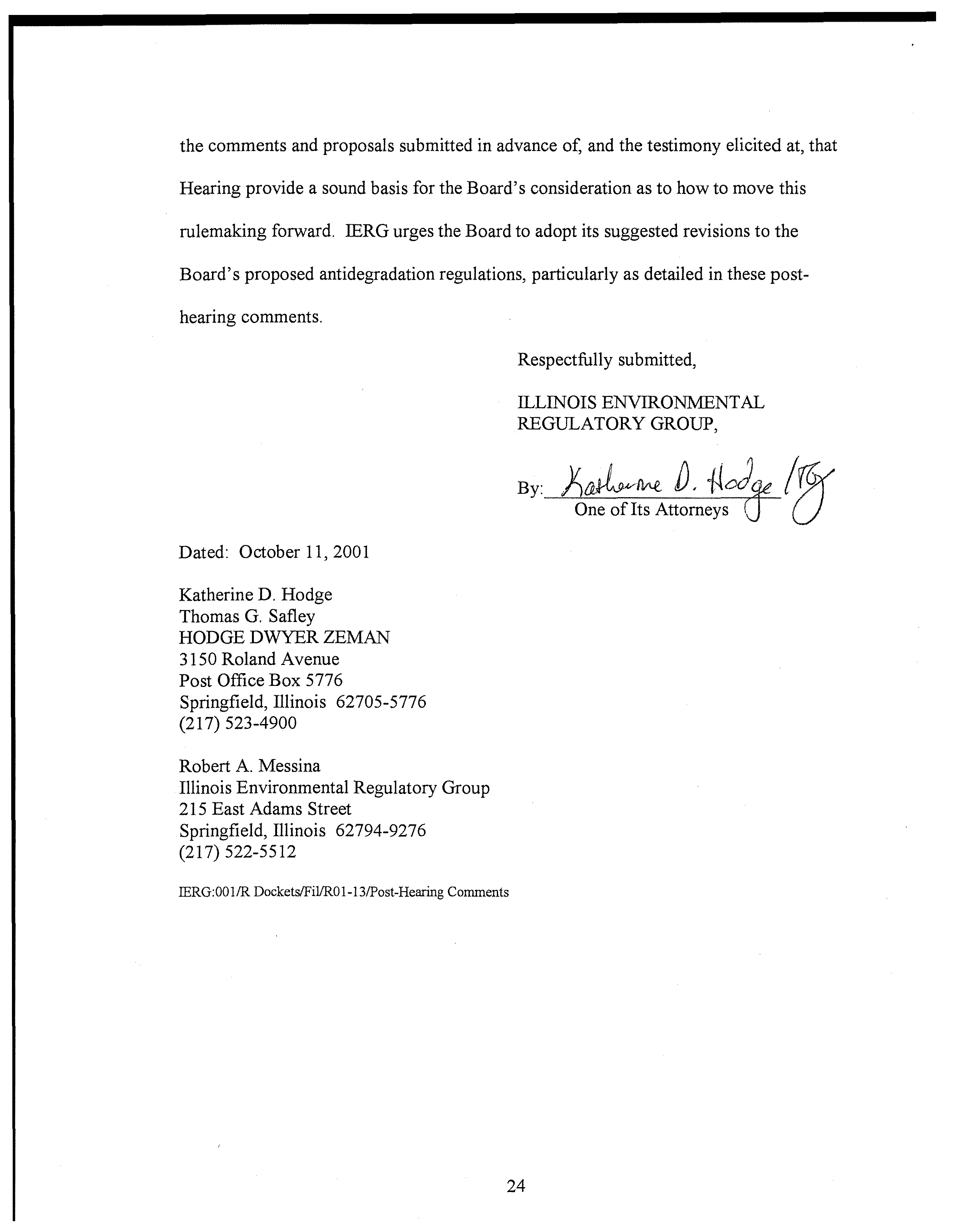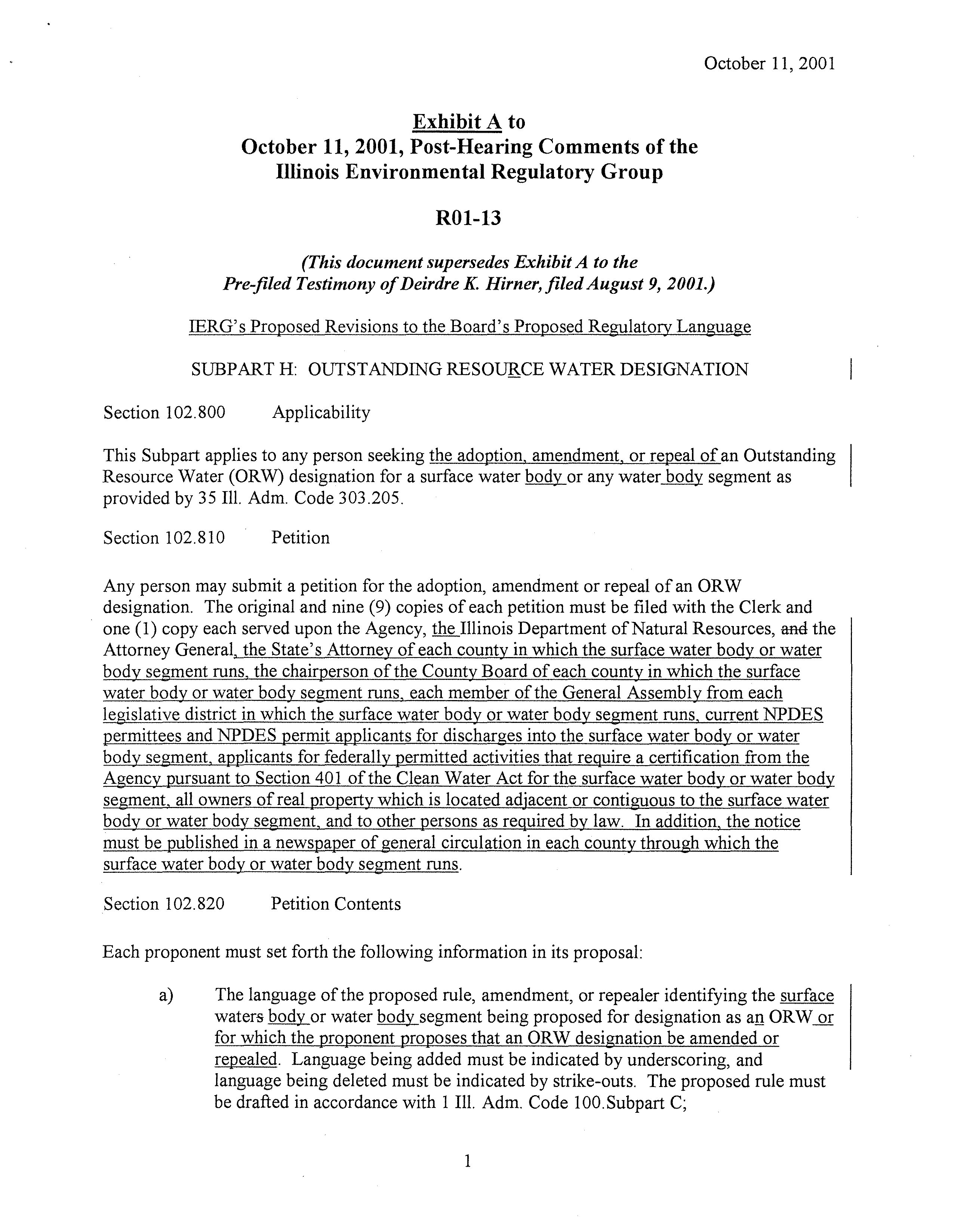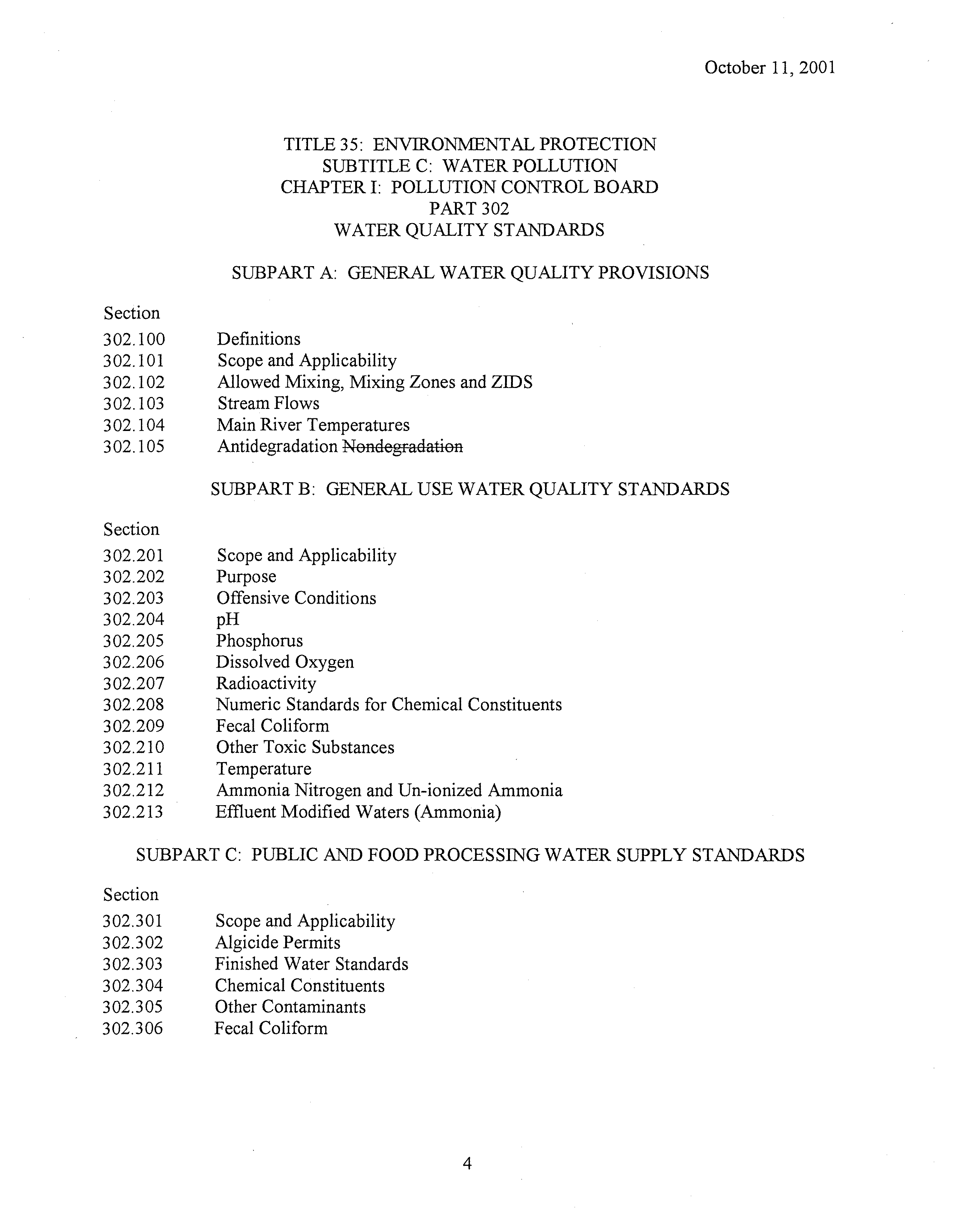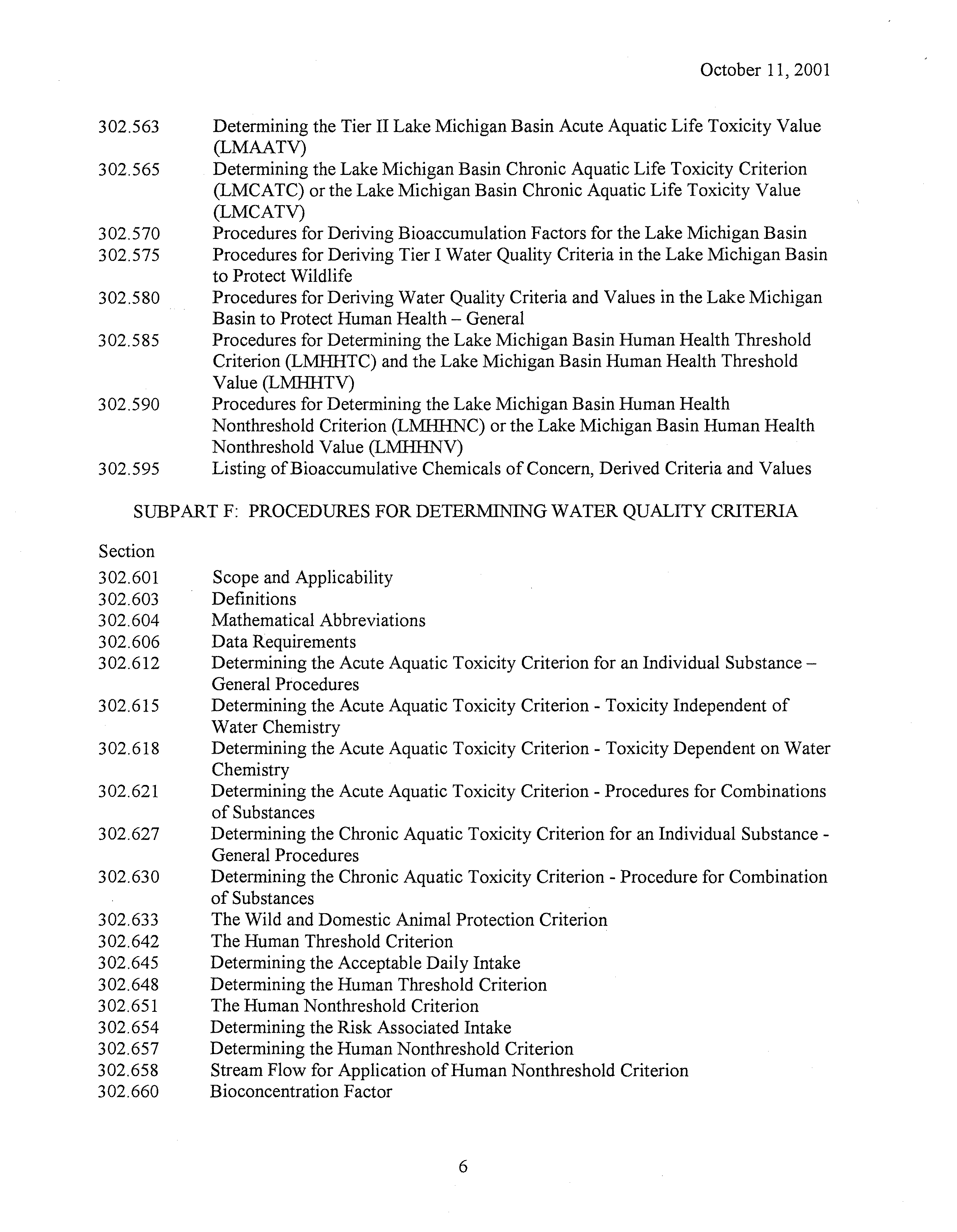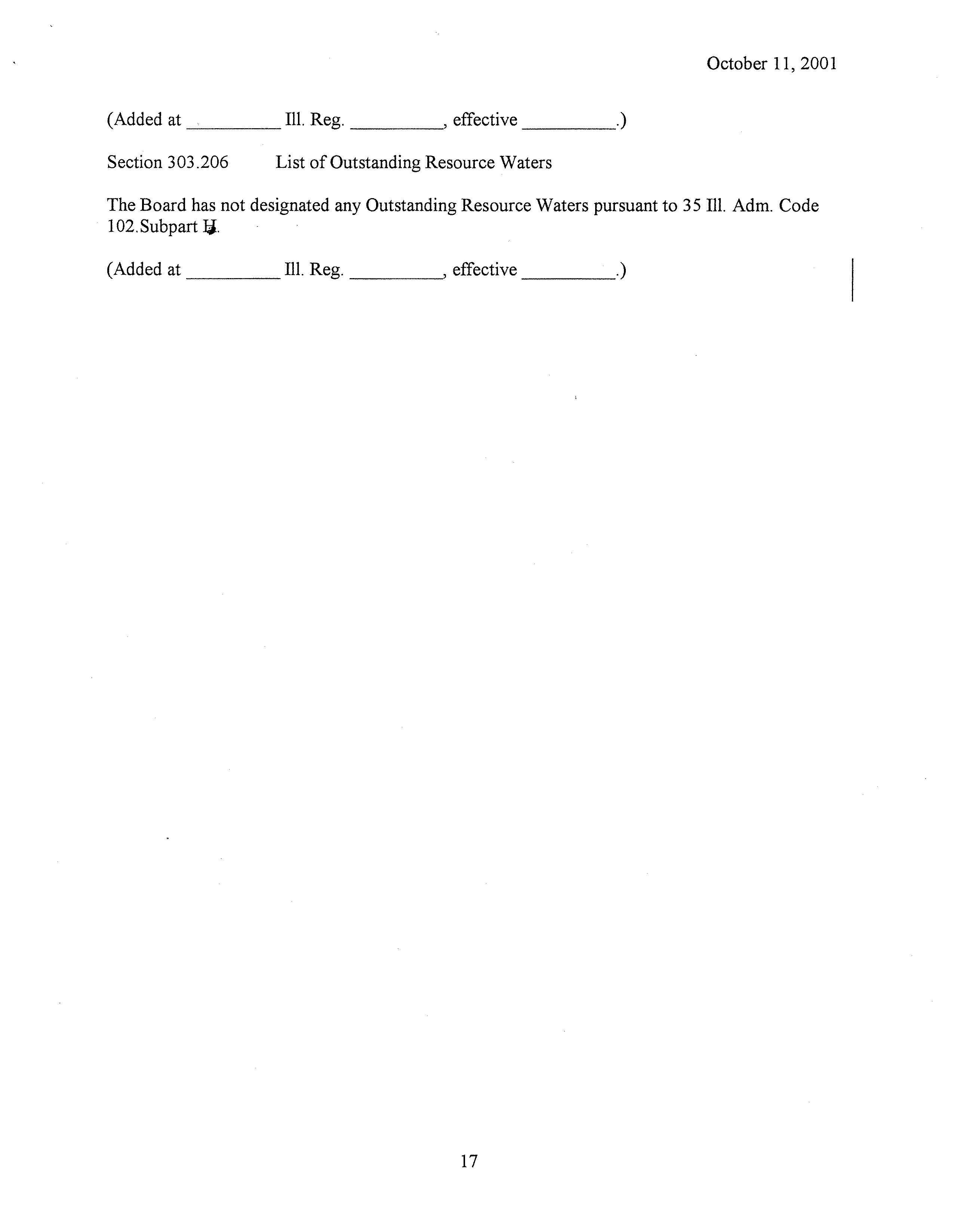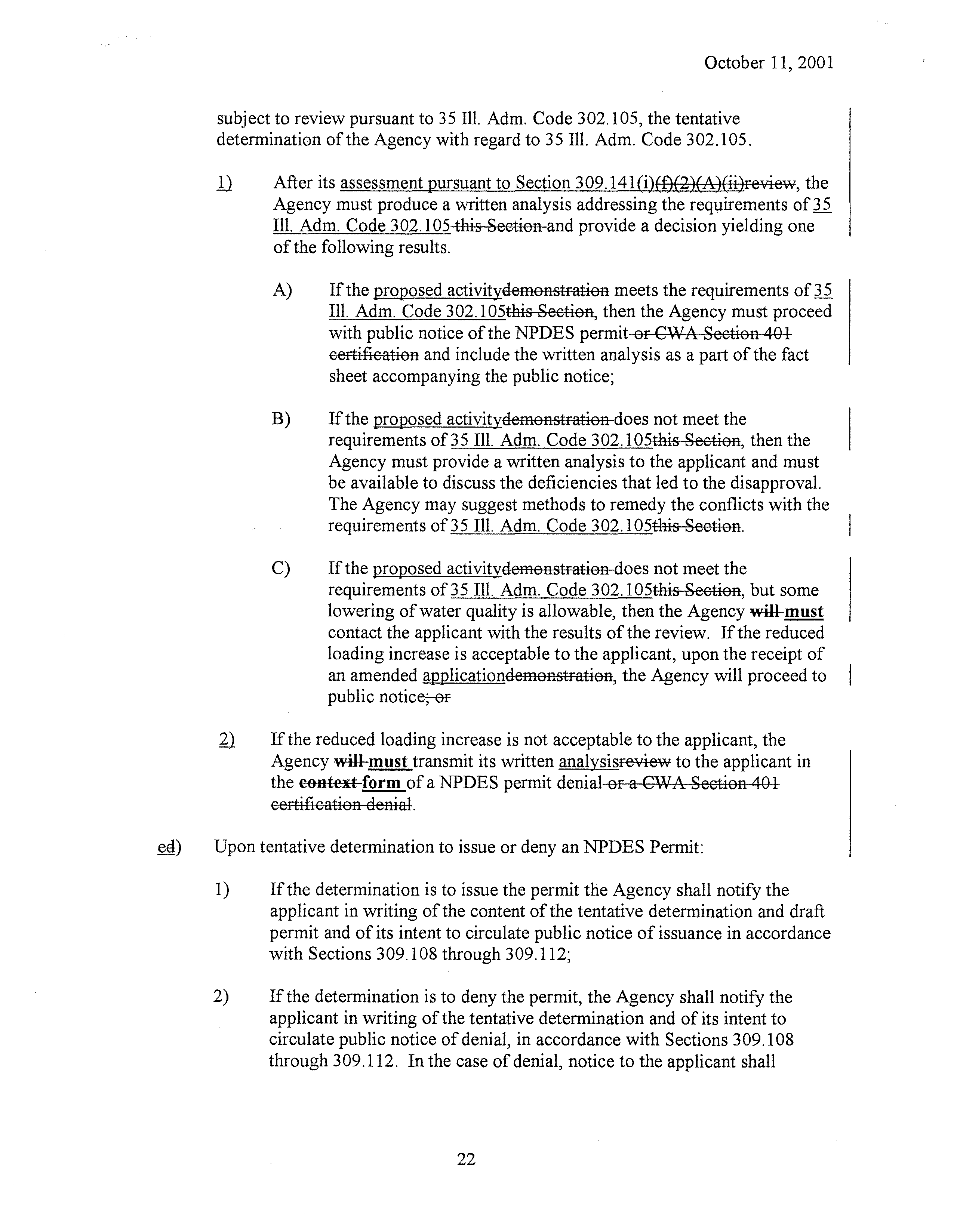RECEIVED
CL’~RK’SO~YCE
‘CT
I
I
2001
BEFORE THE ILLINOIS POLLUTION CONTROL BOARD
STATE OF IWNOlS
Pollution Control Board
)
NOTICE OF FILING
TO:
Ms. Dorothy M. Gunn
Clerk ofthe Board
Illinois Pollution
Control Board
James R. Thompson Center
100 West Randolph Street
Suite 11-500
Chicago, Illinois
60601
(VIA FACSIMILE AND
AIRBORNE EXPRESS)
Marie E.
Tipsord, Esq.
Hearing Officer
Illinois Pollution Control Board
James R. Thompson Center
100 West Randolph Street
Suite 11-500
Chicago, Illinois
60601
(VIA FACSIMILE AND
AIRBORNE EXPRESS)
(PERSONS ON ATTACHED SERVICE LIST)
PLEASE TAKE NOTICE that I have filed today with the Clerk of the Illinois
Pollution Control Board
an original and
nine copies ofthe
POST-HEARING
COMMENTS
OF
THE ILLINOIS
ENVIRONMENTAL REGULATORY
GROUP,
a copy ofwhich is herewith served upon you.
Respectfully submitted,
Dated:
October 11,2001
ILLINOIS ENVIRONMENTAL
REGULATORY GROUP,
By:
~
1),
Hc4~
One ofIts Attorneys
~J
Katherine D. Hodge
Thomas G.
Safley
HODGE DWYER ZEMAN
3150 Roland Avenue
Post Office Box
5776
Springfield, Illinois
62705
(217) 523-4900
Robert A. Messina
Illinois Environmental Regulatory Group
215 East Adams Street
Springfield, Illinois
62701
(217)
522-5512
iN THE
MATTER OF:
REVISIONS TO ANTIDEGRADATION
RULES:
35 ILL. ADM. CODE 302.105,
303.205, 303.206,
AND 106.990
—
106.995
)
)
R01-13
)
(Rulemaking)
THIS
FILING
SUBMITTED ON RECYCLED PAPER
CERTIFICATE OF SERVICE
I, Katherine D. Hodge, the undersigned, certify that I have served copies of the
attached POST-HEARING COMMENTS OF THE ILLiNOIS ENVIRONMENTAL
REGULATORY GROUP upon:
Ms.
Dorothy M.
Gunn
Clerk ofthe Board
Illinois Pollution Control Board
James R.
Thompson Center
100
West Randolph Street
Suite 11-500
Chicago, Illinois
60601
Marie E.
Tipsord, Esq.
Hearing Officer
Illinois Pollution Control Board
James R.
Thompson Center
100 West Randolph Street
Suite 11-500
Chicago, Illinois
60601
By facsimile and by overnight delivery by depositing
said documents in an Airborne
Express drop box
in Springfield, Illinois,
on October
11, 2001,
and upon:
SEE ATTACHED SERVICE LIST
by
depositing said
documents in the United States Mail
in
Springfield, Illinois on
October 11,2001.
D
~
/p~~
Katherine D. Ho~e
(J
IERG:OO1IRDockets/FiIIROI-13/COS
—
Post-Hearing Comments2
SERVICE LIST
Ms. Kay Anderson
American Bottoms RWTF
One American Bottoms Road
Sauget,
Illinois
62201
Frederic P.
Andes, Esq.
Barnes &
Thornburg
2600 Chase Plaza
10
South LaSalle Street
Chicago, Illinois
60603
Ms.
Christine Bianco
Director ofRegulatory Affairs
Chemical Industry Council ofIllinois
9801
West Higgins Road
Suite 515
Rosemont, Illinois
60018
Christine S. Bucko,
Esq.
Assistant Attorney General
Illinois
Attorney General’s Office
Environmental Bureau
188 West Randolph Street
20th Floor
Chicago, Illinois
60601
Mr.
Jack Darin
Sierra Club, Illinois
Chapter
200 North Michigan Avenue
Suite 505
Chicago, Illinois
60601
Mr. Albert F. Ettinger
Environmental Law & Policy Center
35 East Wacker Drive
Suite 1300
Chicago, Illinois
60601-2110
Susan M.
Franzetti, Esq.
Sonnenschein Nath
& Rosenthal
8000 Sears Tower
233
South Wacker Drive
Chicago, Illinois
60606
James T.
Harrington, Esq.
Ross & Hardies
150 North Michigan Avenue
Suite 2500
Chicago, Illinois
60601
John M.
Heyde, Esq.
Sidley & Austin
Bank One Plaza
10
South Dearborn Street
Chicago, Illinois
60603
Richard J.
Kissel, Esq.
Gardner,
Carton & Douglas
Quaker Tower
321 North Clark Street
Suite 3400
Chicago, Illinois
606 10-4795
Sharon Marie Neal, Esq.
Law Department
CornEd
-
Unicorn
125
South Clark Street
Chicago, Illinois
60603
Mr. Jerry Paulson
McHenry County Defenders
804 Reginact
Woodstock, Illinois
60098
Ms.
Cindy
Skrudkrud
4209 West Solon Road
Richmond, Illinois
60071
Connie Tonsor, Esq.
Assistant Counsel
Division ofLegal Counsel
Illinois Environmental Protection Agency
1021 North Grand Avenue East
Post Office Box
19276
Springfield, Illinois
62794-9276
Ms.
Georgia Vlahos
Department ofthe Navy
Naval Training Center
2601A Paul Jones Street
Great Lakes, Illinois
60088-2845
IERG:OO1/Fil/RO 1-13/ServiceList
—
MASTER
Charles W.
Wesseihofi, Esq.
Ross & Hardies
150 North Michigan Avenue
Suite 2500
Chicago, Illinois
60601
Mr.
Stanley Yonkauski
Illinois Department ofNatural Resources
524
South Second Street
Springfield,
Illinois
62701
R~CE1VED
CLERK~SOFFICE
OCT
12
2001
BEFORE THE ILLINOIS POLLUTION CONTROL BOARD
STATE OF IWNOIS
iN THE MATTER
OF:
)
Pollution
Control
Board
)
REVISIONS TO ANTIDEGRADATION
)
R01-13
RULES:
35
ILL.
ADM. CODE 302.105,
)
(Rulemaking)
303.205,
303.206, AND
106.990
—
106.995
)
POST-HEARING COMMENTS
OF
THE ILLINOIS ENVIRONMENTAL REGULATORY GROUP
NOW COMES the ILLINOIS ENVIRONMENTAL REGULATORY GROUP
(“IERG”), by
one ofits attorneys, Katherine D. Hodge ofHODGE DWYER ZEMAN,
and for its Post-Hearing Comments
in this matter, states as follows:
I.
INTRODUCTION
Throughout the cooperative, two-year process led by the Illinois Environmental
Protection Agency (“Agency”) to develop the regulations at issue in this rulemaking, the
rulemaking proceeding resulting in the Illinois Pollution Control Board’s (“Board”)
June 21, 2001,
Opinion and
Order (“Board’s Opinion”), and the subsequent Board
Hearing on August 24,
2001, the Illinois Environmental Regulatory Group (“IERG”) has
maintained the following principles:
•
all
increases in loading to waters ofthe State ofIllinois
should not be
subject to the same level
of
antidegradation review by the Agency,
necessitating that the Board grant the Agency flexibility in conducting
such reviews;
•
the Agency’s resources should be targeted to those loadings that are
“truly”
significant, necessitating the inclusion ofcertain exceptions to
the antidegradation assessment requirement;
•
the regulated community requires some degree of certainty as to how
the Board’s antidegradation regulations will be implemented,
necessitating that the regulatory requirements be clearly set forth;
•
the designation ofa surface water body (or water body segment) as an
Outstanding Resource Water
carries such far-reaching restrictions on
the use ofboth land and water that all potentially impacted parties
must be notified ofa proceeding for such a designation, and the
proponent ofsuch a designation must support its petition with detailed
supporting information for development ofthe Record beforethe
Board; and,
•
the Illinois Department ofNatural Resources lacks the statutory
authority to conduct antidegradation assessments or to otherwise
implement
water quality standards.
In support ofthese principles, IERG has offered suggested regulatory provisions,
some of
which the Board has included
in its first notice regarding the antidegradation regulations,
and others the Board has deemed unwarranted.
Throughout this proceeding, the Agency, the Board and all interested participants
have offered detailed comments on how best to protect Illinois waters
from degradation.
The recommendations have been diverse and,
in some instances, at odds.
However, there
is
one issue as to which all participants and the Board agree:
that,
as the Board has
stated, “all proposed increases in pollutant loadings should not require the same level of
review to demonstrate compliance with the proposed antidegradation standard,” but
rather, the rules “should
allow the Agency to
decide on a case-specific basis what level of
review is appropriate.”
Board’s Opinion at
14.
(Emphasis added.)
All participants have
unequivocally recognized this principle.
~
Transcript ofAugust 24, 2001,
Hearing (“August 24, 2001, Transcript”) at p.
8,
1.
12,
to p.
12,
1.13
(testimony ofMs.
DeirdreK.
Hirner); p.
51,
11.
15 to
17
(testimony ofMs.
Cindy Skrukrud); p.
59,11.
9 to
13 (testimony ofMr. Robert J. Moore).
1ERG discusses this issue offlexibility below.
IERG also
addresses additional
concerns and comments that it has regarding the Board’s proposed regulations.
Some of
2
these comments have been developed through consultation with- the Agency and/or
representatives of the Environmental Groups, and reflect an agreement among the
participants as to
appropriate revisions to the Board’s proposed regulations.
IERG
respectfully requests that the Board take all ofthese concerns and comments
into
consideration as the Board prepares to issue its
proposed antidegradation regulations for
second notice.
II.
THE BOARD MUST PROVIDE THE AGENCY FLEXIBILITY IN
CONDUCTING ANTIDEGRADATION ASSESSMENTS.
The Board has indicated that, as proposed, Section 302. 105(c)(2) “allows the
Agency to decide on a case-specific basis what level ofreview is necessary,” and
provides the Agency the flexibility it needs to determine the depth and degree of analysis
to be completed for individual antidegradation assessments.
Board’s Opinion at
14,
As
IERG indicated at pages
eight and nine ofthe testimony ofDeirdre K. Hirner that was
pre-filed for presentation at the August 24, 2001, Hearing (“1ERG’s Pre-Filed
Testimony”), and
as emphasized in
oraltestimony before the Board, August
24, 2001,
Transcript at 8-10, IERG maintains that the language ofproposed Section 302.105(c) is
drafted in
such a manner as to place undue restrictions on the Agency’s ability to
exercise
flexibility in the antidegradation review process.
IERG has held discussions with the Agency regarding this issue since the August
24, 2001,
Hearing on the Board’s Opinion.
In light ofthese discussions, IERG and the
Agency agree that the Board’s proposed Section 302.105(c)(2) should be revised to
include the following language:
The assessment to determine compliance with this
Section 302.105 must
be made on a case-by-case basis.
3
See Exhibit A’ at
10; Agency October
5,
2001, Comment (“Agency Comment”)
at
7.
IERG and the Agency also agree that similar language should be included in what
is currently the Board’s proposed Section 302. 105(f)(1), the Agency’s implementation
procedures.2
~
Exhibit A at
25;
Agency Comment at
3 8-39.
Further,
in this same regard, IERG offers the following revision to the Board’s
proposed Section
302.
105(c)(2)(B),
in
an effort to ensure the Agency
discretion to
conduct an antidegradation review and
assessment for each permit application on a case-
by-case basis:
2).
.
.
In making this assessment, the Agency must:
A)
Consider the fate and effect ofany parameters proposed for
an increased pollutant loading; and
B)
On a
case-by-case basis, A~ssurethe following:
IERG’s Proposed Revised Section
302. 105(c)(2)(,B)
(~
Exhibit A at
10).
IERG respectfully asks the Board to note this language has been revised from the
revision IERG offered in its Pre-Filed Testimony and in Exhibit
A thereto.
IERG has
revised this language in
deference to the concerns expressed by representatives ofthe
environmental community at the August 24, 2001, Hearing.
~
August 24, 2001,
Transcript at 23, 24-25, 32-34.
As Ms. Deirdre K. Hirner ofIERG stated at that Hearing,
1
Exhibit A to these Post-Hearing Comments details IERG’s proposed revisions to the Board’s proposed
regulatory language.
This Exhibit supersedes the similar exhibit filed by IERG as Exhibit A to IERG’s
August 9, 2001, Pre-Filed Testimony.
2
See discussion below regarding the
Agency’s proposal to transfer the Board’s proposed Section
302.105(1) to Part 309 of the Board’s regulations.
4
it was never IERG’s intent to preclude the Agency from considering any
criteria
it deemed necessary in the conduct of an antidegradation review.
Rather, it is,
and
always has been, IERG’s intent to propose language that ensures the Agency the
flexibility needed to consider the
depth and degree ofstudy ofeach ofthe criteria which
the Agency deems appropriate on a case-by-case
basis.
Finally on this point, IERG again strongly encourages the Board to
clarify the
antidegradation regulations to allow the Agency the flexibility
necessary to
establish the
level ofreview required to demonstrate compliance with the antidegradation standard for
each individual permit application, with the complexity and
scope of review dependent
upon the nature ofthe proposed activity, the pollutant, and the character ofthe receiving
stream at issue.
ifi.
THE REGULATIONS SHOULD IDENTIFY ACTIVITIES NOT SUBJECT
TO FURTHER ANTIDEGRADATION ASSESSMENT SO AS
TO ALLOW
THE AGENCY TO TARGET ITS
RESOURCES TO TRULY
SIGNIFICANT LOADINGS.
It is evident that the Board and the Agency agree that certain activities do
not
require a separate antidegradation demonstration, as such activities essentially have been
subject to reviews similar to antidegradation reviews under other authorities,
and thus,
conducting
a separate antidegradation demonstration would be an unnecessary
redundancy.
The Board identified seven such activities in its
First Notice Opinion and
Order under proposed Section 302.105(d), as did the Agency in an attachment to its
March 20, 2001, filing of“CLOSING COMMENTS.”
IERG supports the proposed
adoption ofthese exceptions.
In its Pre-Filed Testimony and at the August 24, 2001, Hearing, IERG requested
the Board
consider the adoption of four additional exceptions,
including an exception for
5
de minimis increases
in pollutant loading.
IERG’s Pre-Filed Testimony at 5-8,
10-14;
August 24, 2001, Transcript,
at
10,
12-13.
On review of arguments presented at hearings
throughout this proceeding,
and in
supporting documents, IERG now requests that the
Board
consider the addition of only one
additional exception in its
Opinion and Order
issuing the Board’s antidegradation regulations for second notice.
At the August 24, 2001, Hearing
on the Board’s Opinion,
an extensive discussion
ensued regarding the scope ofthe Board’s proposed Section 302.105(d)(5), which would
except discharges ofcertain non-contact cooling waters from the antidegradation
assessment requirement.
~
August 24, 2001, Transcript
at 25-27.
This discussion,
which broached the Agency’s concern with the language and industry’s need for the
exception, afforded the opportunity for post-hearing dialogue.
Through that dialogue,
the
Agency and the regulated community have come to understand that application ofthis
exception to non-contact cooling waters containing only
the additive chlorine, and where
dechlorination occurs before discharge,
is an acceptable compromise.
Accordingly,
IERG proposes the following amendmentto the Board’s proposed Section
302.
105(d)(5):
5)
New or increased
discharges of a non-contact cooling waterj
A)
without additives,
except as provided
in subsection
(d)(5)(B)
ofthis Section,
returned to the same body of
water from which it was taken~
as defined by 35 Ill.
Adm.
Code 352.104, provided that the discharge complies with
applicable Illinois thermal standards;.~L
~)
containing chlorine when the non-contact cooling water is
treated to
remove residual chlorine and
returned to the
same body ofwater from which it was taken, as defined in
35 Ill.
AiIm.
Code 352.104,
provided that the discharge
complies with applicable Illinois thermal and effluent
standards.
See Exhibit A at
12.
6
The Agency supports and has also proposed this revision ofSection
302. 105(d)(5)
to the Board.
~
Agency Comment at 7-9.
IERG respectfully requests that the Board
include this revision in its Opinion and Order issuing the Board’s antidegradation
regulations for second
notice.
-
Also, IERG has reconsidered its request that the Board include a de minimis
exception in the antidegradation regulations.
The Board has clearly articulated its belief
that “the Agency should have the opportunity to review any proposed increase in
pollutant loading.”
Board’s Opinion at
16.
And, IERG concurs that concerns expressed
by
other participants in this proceeding, namely, that performing de minimis calculations
could tax Agency resources and
call matters oftiming and
scope ofreview into
consideration, may warrant merit.
As noted by Deirdre K. Hirner at the August 24, 2001,
Hearing, however,
to those very few industries that could make use ofa de
minimis
demonstration, such a demonstration would be
a valuable tool
in terms ofavoiding
potential delays in
processing NPDES permits.
August 24, 2001,
Transcript at
10.
Therefore, 1ERG would ask the Board’s consideration ofan addition to proposed Section
302.105(c)(2)(C) to allow the Agency to consider a de minimis demonstration as one of
its
sources ofinformation in
making an antidegradation assessment.
S.~
Exhibit A at
11.
This demonstration would be prepared by the permit applicant, and show that the
proposed increased in loading
ofa pollutant, other than a bioaccumulative chemical of
concern,
does not utilize more than ten-percent ofthe available assimilative capacity of
the receiving water forthe constituent under consideration.
j4,,
Also, IERG has withdrawn its request for an exception from the antidegradation
assessment requirement for discharges authorized by the Board or by a Court.
IERG
7
withdraws this request based on its understanding that the Agency does not consider itself
to have the authority to override, by an antidegradation assessment, a Board
or Court
authorization for a discharge.
And, IERG has withdrawn its request for an exception for
site stormwater discharges.
IV.
THE REGULATORY
LANGUAGE MUST BE
CLEARLY
STATED TO
PROVIDE CERTAINTY AS TO HOW
THE
ANTIDEGRADATION
REGULATIONS WILL BE IMPLEMENTED.
A.
Board’s Proposed Section 302.105(c)(2)
—
Antidegradation Assessment
~~j~ger
To properly comply with the antidegradation review process, the regulated
community must be able to clearly identify the trigger that begins that process.
IERG,
the Agency and the Board concur that the Board’s proposed language
at Section
302. 105(c)(2) makes clear that the antidegradation assessment requirement applies only
to increases in
pollutant loading that necessitate the issuance of a new, renewed, or
modified NPDES Permit.
IERG initially had proposed adding the modifying language
“with a new or increased permit limit” in order to appropriately clarify the trigger for the
antidegradation assessment process.
However, discussions with the Agency subsequent
to the August 24, 2001, Hearing have led to
an understanding that this proposed language
could be
interpreted to restrict antidegradation review to only those pollutants having a
“limit” expressly stated in a permit.
It was not lERG’s intent to so impede the Agency in the conduct ofits duties.
Rather, IERG’s intent was to explicitly state that which is implicit in the Board’s
proposal:
that at least forthose
constituents for which a limit is expressly stated in
a
permit, the antidegradation assessment requirement is triggered by a permit applicant’s
request for an increase in
loading that would result in an exceedence ofthe expressly
8
stated limit.
Likewise, an increase in
a pollutant discharge for which no permit limit is
stated, but for which the Agency has authorized a level of loading,
is not subject to
antidegradation review as long
as the increased discharge does not exceed the authorized
level ofloading.
In light ofthese discussions, IERG has reconsidered its request that the Board
include the “with a new or increased permit limit”
language in the Board’s proposed
Sections 302.
105(c)(2)
and (f)(1).
Instead, IERG believes that the trigger for
antidegradation review can by made clear by revising Section
302.
105(c)(2)
to provide as
follows:
The Agency must assess any proposed increase in pollutant loading that
necessitates the issuance ofa new, renewed or modified NPDES p~ermit~
or any activity requiring a CWA Section 401
certification~
to determine
compliance with this
Section 302.105
provided, however, that if a
pollutant is subject to an
existing permit limit, an assessment
shall not be
required unless the proposed increase in pollutant loading would
result in
an exceedence ofsuch permit limit.3
The assessment to
determine
compliance with this Section 302.105 must be made on a case-by-case
basis.
In making this assessment, the Agency must:
See ExhibitAat
10.
IERG also proposes to add similar language to the Agency’s proposed Section
309.141(i).
See Exhibit A at 25.
It is IERG’s understanding that the Agency agrees
conceptually with these revisions.
~
Agency Comment
at
10-11.
IERG respectfully
requests that the Board include these revisions in
its Opinion and
Order issuing its
antidegradation regulations for second notice,
so as to avoid confusion and
the potential
for future litigation regarding this issue.
See discussion of this
proposed revision to
Section
302.
105(c)(2)
below.
9
B.
Board’s Proposed Section 302.105(b)(1)(B)
—
Existing
Site Stormwater
Discharges into ORWs
The Board’s proposed Section 302.105(b)(1)(B) provides for “existing site
stormwater discharges” into ORWs.
IERG has previously requested that the Board revise
the language ofthis provision, but
hereby withdraws that request.
IERG is comfortable
with the language ofthe Board’s proposed Section 302. 105(b)(1)(B).
C.
Board’s Proposed Sections 302.105(b) to (d)
—
Review of Discharges to
ORWs
The Board’s proposed Section
302. 105(b)(3)(B) provides that the short-term,
temporary activities and
the stormwater discharges affecting the water quality of ORWs
authorized under proposed Section
302. 105(b)(1) may occur only if they are also
“necessary for an activity that will improve water quality in the ORW.”
Based on the
testimony ofthe Agency’s witness Mr. Toby Frevert, this
Section
has been structured to
allow
such load increases in an ORW.
While the circumstances
in which such increased
loading to
an ORW are to be very few and limited,
the provision was developed as an
allowance.
The requirementthat the activity also improve water quality is contrary to the
allowance ofa limited discharge.
Accordingly, IERG assumes that the Board did not intend proposed Sections
302. 105(b)(3)(B) and (C) to apply to the activities authorized
in proposed Sections
302.
105(b)(1)(A)
and
(B).
TERG has consulted with the Environmental Groups regarding
this issue,
and
it is IERG’s understanding that the Environmental Groups support the
following revision to clarify Section 302.
105(b)(3):
3)
Any
activity listed
in
subsection (b)(1) or any other proposed
increase
in pollutant loading to
an ORW must
also meet the
following requirements:
10
A)
All
existing uses ofthe water will be fully protected; and,
B)
Except for activities falling under one ofthe exceptions
provided in
Subsection (b)(1)(A) or (B) above,
The proposed increase in pollutant loading
is
necessary for an activity that will improve water
quality in the ORW;
and
?jI).
The improvement could not be practicably achieved
without the proposed increase in pollutant
loading.
See Exhibit A at 9-10.
IERG also notes that it is still unsure of the intent the Board’s proposed
requirement that increases in
loading to ORWs improve water quality.
IERG assumes
that this means, for example, that if an increase in the level of one contaminant in
a
discharge to an ORW allowed a party to
decrease
the
levels ofthree other contaminants
in the discharge, the increased discharge ofthe first contaminant to the ORW would be
allowed, because it is necessary to improve water quality (i.e., throughthe decrease in the
other three contaminants).
IERG requests that the Board clarify the intent ofthis
requirement in the Board’s Opinion and
Order issuing the antidegradation regulations for
second notice.
Finally,
1ERG proposes the following revisions
to the Board’s Proposed
Sections
302.
105(b)(2),
(4), and
(5),
which revisions are intended to incorporatethe Agency’s
proposed revisions
to these Sections and to clarify what IERG understands to be the
Board’s intent in those Sections:
2)
Any activity inunder subsections (b)(1)(A) or (b)(1)(B) ofthis
Section or any other increase in pollutant loading that
requireswould necessitate the issuance ofa new, renewed or
modified-aNational Pollutant Discharge Elimination System
(NPDES) Permit or require a Clean Water Act (CWA) Section 401
11
certification must also
comply with subsection (c)(2) ofthis
Section.
4)
Any proposed increase in pollutant loading to an ORW that would
requir~ing
the issuance of a new, renewed, or modifiedan NPDES
permitPermit or a CWA 401 certification for an
ORW must be
assessed pursuant to 35 Ill. Adm.
Code 309. 141(i)subsection (f) to
determine compliance with this
Section.
~)
Any activity requiring
a CWA Section 401
certification for an ORW must
be assessed during the Section 401
certification process to determine
compliance with this Section.
SeeExhibitAat9,
10.
IERG respectfully requests that the Board include these revisions in
its Opinion
and Order issuing the Board’s antidegradation regulations for second notice.
D.
Codification ofAgency Implementation Rules
The process by which the Agency requests information from an applicant, reviews
that information,
and makes the results ofits assessment known to the public is
inextricably linked to achieving antidegradation.
It was the need for certainty as to how
the assessment and
review process would be implemented to achieve the standard that led
IERG to request that the Board include the Agency’s implementation regulations within
the body ofthe Board’s rules.
March
19,
2001, Post-Hearing Comments ofIERG at
10.
The Board agreed with this suggestion,
and,
again, IERG thanks the Board for doing
so.
At the August 24,
2001, Hearing on the Board’s Opinion, the Agency requested
that the Board place the Agency’s implementation rules regarding antidegradation in Part
309 rather than in Part 302 ofthe Board’s rules.
It is IERG’s understanding that the
Agency proposes to include the Board’s proposed Section 302. 105(f)(1), (2), and (3) in
35 Ill.
Admin. Code
§~
309.103(a), 309. 141,
and 309.108
and 309.113,
respectively.
12
IERG has considered and supports this proposal by the
Agency, and IERG has set
forth
proposed non-substantive revisions to the Agency’s proposed revisions to Part 309
in
Exhibit A at 2 1-26.
It is also IERG’s understanding that the Agency has proposed that the Board
delete the portions ofthe Board’s proposed Section 302.105(f) addressing the procedures
by which permit
applicants interact with the Agency prior to
seeking a permit.
IERG has
also considered and supports this proposal by the Agency.
E.
Board’s Proposed Section
302.105(d)(6)
—
Waters Of Particular
Biological Significance
Among
other exceptions from the antidegradation assessment requirement, the
Agency proposed an exception for “~discharges permitted under a current general
NPDES permit as provided by 415 ILCS
5/39(b).”
Agency’s Proposed Section
302.
105(d)(6).
In its Opinion, the Board
added a condition to this
exception, which
requires that:
the Agency must assure that individual permits
or certifications
are
required prior to all
new pollutant loadings or hydrological
modifications
that necessitate a new, renewed or modified NPDES permit or CWA,
Section 401
certification that affect waters ofparticular biological
significance.
Board Opinion at 34.
(Emphasis Added.)
The Board does not discuss “waters of particular biological significance”
in its
Opinion, and this language was never discussed during the course ofthe Agency’s work
group meetings.
Accordingly, IERGwas uncertain of the meaning ofthis language and
assumed that the Board must have meant to refer to ORWs.
~
IERG’s Pre-filed
Testimony at 22-23.
13
In theirPre-Filed Testimony,
and at the August
24, 2001,
Hearing on the Board’s
Opinion,
certain Environmental Groups4 supported the inclusion ofthis language
in
Section 302. 105(d)(6).
August
10,
2001, Memorandum Regarding the Proposed Rule,
First Notice, ofthe Environmental Groups at 2 (“Environmental Groups’
Memorandum”); August
10, 2001, Pre-Filed Testimony ofRobert J. Moore at 4-5;
August 24,
2001, Transcript at 66, 76-78.
The Environmental Groups further argued that
the Agency should rely on a 1991
report prepared forthe Illinois Department of
Conservation and titled “Biologically Significant Illinois Streams” to
determine what
constitutes a “water
ofparticular biological
significance.”
jj
It still
appears to IERG that the Board’s reference to “waters ofparticular
biological
significance” was a typographical error,
and that the Board intended to refer to
ORWs.
Using the term “waters of particular biological
significance” would create a
fourth class ofwaters,
somewhere between “high quality waters”
and “outstanding
resource waters,” and the Board has never indicated any desire to create an additional
class ofwaters.
Further,
there has been no discussion among the participants in this
rulemaking and no presentation ofevidence to the Board regarding how a fourth
class of
waters should be defined, what
it should comprise,
etc.
Accordingly, IERG opposes the
inclusion ofthis language in Section
302.105(d)(6) and respectfully requests that the
Board revise this Section to refer to ORWs.
See Exhibit A at
12.
Further,
even if the Board had intended to refer to “waters ofparticular biological
significance,” IERG opposes relying on the
1991
Report titled “Biologically Significant
Illinois Streams” (“1991 BSIS Report”) to determine what water bodies are “of particular
4The
Environmental Law and Policy
Centerof the Midwest;
Friends ofthe Fox
River,
Prairie
Rivers
Network; and
the illinois
Chapter
of the Sierra
Club (hereinafter collectively “Environmental Groups”).
14
biological
significance.”
The 1991
BSIS Report classifies water bodies as “biologically
significant” if one of three criteria is met:
(1) the water body
is classified as an “A’
category” stream in a 1989 report entitled “Biological Stream Characterization:
A
Biological Assessment ofIllinois Stream Quality” (“BSC”); (2) the water body has
“mussel diversity”; or (3) “a threatened,
endangered, or watch list
species has been
recorded in
the waterbody
since
1980.”
1991
BSIS Report at
1-2,
6.
The problems
with this approach are as follow.
First, the Environmental Groups have not filed any evidence that the methodology
used to prepare the BSC and the criteria used to identify waters ofbiological significance
have been made available for review by the regulated community orthe scientific
community, and IERG is not aware ofany such review having taken place.
Without such
review, the Board has no way to ascertain whether any scientific basis exists forthe
conclusions ofthe BSC,
and thus, whether the 1991
BSIS Report should have relied on
the BSC.
Likewise, the Board has no way to
ascertain whether any scientific basis exists
for the conclusions ofthe
1991 BSIS Report regarding what waters are “biologically
significant.”
Second, the authors ofthe
1991
BSIS Report explain that the data on which they
relied in preparing the
1991
BSIS
Report was incomplete.
For example, the
1991
BSIS
Report
states that “~other
parameters” that the Report did not consider are relevant to
determining the “biological
significance” ofa water body,
including “water quality,
land
use, unusual
habitants, naturalness ofthe ecosystem, and natural divisions.”
1991
BSIS
Report at 3.
The authors of the
1991
BSIS Report also state that they focused only on
water bodies with endangered, threatened, or watch list species,
fish diversity,
and mussel
15
diversity, and that “data on additional groups would refine the
Report’s
analysis.”
1991
BSIS Report at 6.
IERG is troubled by these admitted shortcomings, especially the lack
ofphysical habitat data and data on aquatic insect fauna in the
1991
BSIS Report.
For
example, for several ofthe water bodies identified as “biologically significant,” the
1991
BSIS Report only identifies the presence ofan endangered, threatened, or watch list
species, and then states:
“No data on stream characteristics is available for this site.”
See, ~
1991
BSIS Report at
327.
Third, the data used in the
1991
BSIS Report regarding the presence of
endangered, threatened, or watch list species in water bodies is now out ofdate.
The
1991
BSIS Report was prepared ten years ago, and the data on which it relies to conclude
that endangered, threatened, or watch list species are present were gathered before that.
The Environmental Groups have presented no evidence that the conclusions ofthe
1991
BSIS Report regarding the presence ofsuch species are currently accurate, or even if they
are, that these conclusions will remain accurate in the future.
Fourth, in some cases, the
1991
BSIS Report itself describes that a water body
that it considers “biologically significant” cannot be preserved for one reason or another.
For example, the
1991
B SIS Report characterizes Sammons
Creek in Alexander County,
Illinois,
as “biologically significant” because ofthe presence ofa threatened fish
identified in that creek
in 1990.
1991
BSIS Report at 266-267, 268-269.
However, the
Report also
states that “~preservation
potential” for Sammons Creek “is low because of
the local agricultural practices.”
Içj.
See also,
~
1991 BSIS Report at 352 (discussion
of Brushy Slough
in White County, Illinois).
16
In light ofall ofthese concerns, even if the Board had meant to refer to “waters of
particular biological
significance,” IERG would oppose the use of the
1991 BSIS Report
to determine what water bodies are ofparticular biological significance.
F.
Other Proposed
Minor Language Revisions
Finally, in Exhibit A to these Comments,
IERG also has proposed other minor,
but important, revisions to the Board’s proposed regulations.
IERG does not intend these
proposed revisions to affect the substance ofthe regulations, but merely to clarify the
language ofthe regulations.
IERG respectfully requests that the Board include these
minor, but important, revisions in
its Opinion and
Order issuing the Board’s
antidegradation regulations for second notice.
V.
THE DESIGNATION OF OUTSTANDING RESOURCE WATERS
REQUIRES THAT ALL POTENTIALLY IMPACTED PARTIES BE
NOTIFIED
AND
OBLIGATES
THE
PROPONENT TO SUPPORT ITS
PETITION WITH DETAILED INFORMATION.
IERG continues to have concerns with two of the Board’s proposals relating to
proceedings to designate ORWs or to repeal or modify such designations.
IERG initially
had voiced its preference that the Board use an adjudicatory proceeding to consider ORW
designations due to the associated use limitations placed on a water body so designated
and on
its surrounding lands,
indeed the
entire watershed.
Subsequently, IERG was
convinced by the Board’s arguments favoring a rulemaking proceeding and
supports the
Board’s First Notice proposal in this regard.
However, IERG has not lost sight ofthe
significance ofthe ramifications ofa decision to designate a water body as an ORW.
IERGmaintains
that, if a rulemaking proceeding is
to be used to consider
petitions regarding ORW designations,
the Board must address two
issues ofconcern as
follows.
17
A.
Potentially Impacted Landowners and Interested Parties Must
Receive Adequate Notification.
IERG renews its proposal that the Board strengthen the notification requirements
for petitions relating to ORWs, as outlined in IERG’s Pre-filed Testimony.
~
IERG’s
Pre-Filed Testimony
at
17.
The Board requires newspaper publication ofpetitions to
designate special resource groundwaters and petitions for adjusted standards.
~
35
Ill.
Admin.
Code
§~
104.408(a),
620.260.
And, the Board requires both newspaper
publication and additional written notice to
specified persons regarding petitions for
variances from the Board’s regulations.
~
35
Ill.
Admin.
Code
§
104.214(a),
(b).
Given that Mr. Frevert has acknowledged that:
the ramifications of a
decision to
designate a water body as an ORW
are fundamentally more significant than the ramifications of a typical
adjusted standard or even a
statewide standard in that we are not setting
a
target to protect
an environmental use here.
.
.
.
we
are setting an
absolute prohibition on some activities,
Transcript ofNovember 17,
2000, Hearing at 88,
11.
10-16, and that Mr. Frevert has
indicated there is:
an
obligation to disseminate adequate information regarding
a proposal to
designate
an ORW
to start the process and
to
assure
that potentially
affected
property owners and other citizens have adequate notice,
jj~p.
88,
1.
22 to
p.
89,
1.
1, IERG is unequivocally convinced that its proposed expanded
notification requirements arejustified
and strongly urges the Board to adopt the necessary
notification requirements.
To facilitate the Board’s favorable consideration ofthis request, TERG further
notes that atthe August 24,
2001, Hearing on the Board’s Opinion,
Mr. Frevert stated
that the Agency could assist
in the notification process,
indicating that once the Board
determined that a petition regarding an ORW would move forward, the Agency:
18
would certainly be
committed at that point to do whatever we can to help
you identify potentially affected
parties, and, you know, either giving
you current permit holders within that affected
area mailing address or
perhaps even agree to do a mailing for you or for someone.
August 24,
2001, Transcript at
87,
11.
15-20.
IERG greatly
appreciates the Agency’s willingness to assist with the notification
process proposed by TERG,
and urges the Board to accept the Agency’s offer and to
include the language proposed by IERG in Exhibit A hereto regarding notification in
ORW proceedings.
~
Exhibit A at
1.
B.
Proponents of an ORW Designation Have an Obligation to Support
the Petition with Detailed Supporting Information for the
Development ofthe Record
before the Board.
In response to questions at the August 24, 2001, Hearing, Mr. Frevert indicated
that designating an ORW:
is not just adjusting a standard~;
it’s designating an entirely new use, an
entirely new use concept.
In that regard, it does have the potential
significantly to affect
people.
August 24, 2001, Transcript at 88.
IERG believes that any proceeding that will set “absolute
bans” on the use of land
and which has such potential for severe impact on people’s lives and livelihoods demands
that the proponent ofan
ORW designation have an obligation to submit sufficient
supporting documentation to the Board to prove that the designation is warranted.
IERG
initially advocated that the designation ofa water body as an
ORW take place in the
context of an adjudicatory proceeding because the burden ofproofon a proponent in an
adjudicatory proceeding before the Board is well established, while the burden ofproof
on a proponent in
a rulemaking proceeding is not.
19
Arguments offered by the Board in its First Notice Opinion and Order, Board’s
Opinion at 20-23, and reinforced at Hearing, August 24,
2001,
Transcript at p.
44
11.
12-
17,
p.
45
11.
1-6, p.
46
11. 10-15, have convinced
IERG that the procedure for designating
ORWs can appropriately progress in the regulatory arena.
However, the regulated
community maintains that the proponent ofa regulatory proceeding before the Board,
even ifthat proponent is the Agency, does have a minimum burden in
moving the
proposal
forward, if only by presenting sufficient
information to demonstrate the need for
the proposed regulation.
The essence ofthis matter was best articulated by Dr. Tanner Girard in his query
regarding his perception of IERG’s concern with the word “statement” as used in the
Board’s proposed Section 102.820.
Dr.
Girard accurately suggests that “statement” can
be viewed as a narrow term allowing one to put forth a petition for ORW designation that
does not include supporting evidence.
August 24,
2001, Transcript at 49, 11.10 to
15.
IERG holds that the proponent ofan ORW designation,
modification or repeal has an
obligation to offer sufficient evidence in
support ofits position so as to allow the Board
to meaningfully consider the factors
set forth in Section 27 ofthe Illinois Environmental
Protection Act.
See 415
ILCS
5/27,
Accordingly, IERG proposes that the Board adopt revisions to the Board’s
proposed Section 102.820 that place proponents ofthe designation, repeal or
modification of an ORW on notice ofthe need to fully support the petition.
The listing of
“Petition Contents”
detailed in
Section
102.820 (b) through (g) requiring the proponent to
submit a “statement” in support ofthe designation must be strengthened by the addition
20
ofthe phrase “with supporting
evidence” for each ofthe specified
criteria, as set forth in
Exhibit A at 2.
These revisions will afford some degree of certainty that the proponent indeed has
a minimum burden to provide
sufficient information in support ofthe designation forthe
Board’s consideration on the Record.
IERG respectfully requests that the Board include
these revisions in the Board’s Opinion
and Order issuing its antidegradation regulations
for second
notice.
Finally, IERG notes that it has withdrawn its request that the Board revise
proposed Section
102.830(b) to place a burden on the proponent ofan ORW designation
to establish the elements required for such a designation.
Rather, IERG now proposes
that Section
102.830(b) state that the Board may designate a waterbody as an
ORW if it
finds that “the evidence set forth in the Record.
.
.
supports” the required elements.
$~
Exhibit A at 3.
VI.
THE ILLINOIS DEPARTMENT OF NATURAL
RESOURCES LACKS
STATUTORY AUTHORITY TO
CONDUCT ANTIDEGRADATION
ASSESSMENTS.
Illinois facilities are heavily regulated in the environmental area.
In numerous
instances, the General Assembly has charged specific state agencies other than the
Agency with authority to administer specific environmental
programs.
Examples include
the Illinois Emergency Management Agency in the Community-Right-To-Know
program; the Illinois Department ofAgriculture as regards agrichemical facility
remediation;
and the Illinois Department of Transportation as regards hazardous material
transportation.
The list goes on, but with a common theme:
the General Assembly
vested authority in
a specified state agency, and the regulated communitywas so advised.
21
This advisement is crucial, because a critical factor in
a business’s compliance strategy is
knowledge ofwho the regulator is,
and the rules that govern those regulators.
The Environmental Groups propose that the Board authorize the Illinois
Department ofNatural Resources (“IDNR”) to participate in the antidegradation
assessment process.
~
Environmental Groups’
Memorandum at 4.
The General
Assembly has designated the
Agency, not IDNR,
as the “water pollution agency for the
state for all purposes ofthe Federal Water Pollution Control Act.”
415 ILCS
5/4(1).
Likewise, the General Assembly has charged the Agency, not IDNR, with the
responsibility to administer permit programs,
including the NPDES permit program and
the antidegradation review process as it takes place in the context ofthat
program.
415
IFLCS
5/4(g).
Only the General Assembly can give IDNR a role in administering the
Water Pollution Control Act orthe permit programs ofthe state.
As the General
Assembly has not done so, IERG opposes the Environmental Groups’
requestthat the
Board add a provision to the antidegradation regulations entitling the IDNR to have such
involvement.
VII.
CONCLUSION
The Agency’s Work Group process and the subsequent Board
proceeding here
have allowed for thorough and comprehensive review and comment by
all
interested
participants.
In addition, the Board has afforded the opportunity to reflect on all
participants’ positions and the rationale for those positions.
IERG has been an active
participant in the process and has given due consideration to all arguments, written and
oral.
To achieve balance between the needs ofthe environment and the burden on the
regulated community, IERG respectfully requests that the Board address the following
22
issues, the subject ofthese comments, in
its Opinion and Order issuing the Board’s
antidegradation regulations for second notice.
1.
The Board must provide the Agency flexibility in conducting
antidegradation reviews to assess any proposed increase in pollutant loading on a case-
by-case basis, by specifically authorizing that flexibility.
2.
The regulations
should provide exceptions for activities not
subject to
further antidegradation review, so as to assist the Agency in targeting its resources to
truly significant loadings.
IERG requests the addition of only a minor modification to
one ofthe Board’s proposed seven exceptions
—
that chlorine be allowed as an additive to
non-contact cooling water, ifthe water is subsequently treated to remove residual
chlorine levels.
3.
The regulatory language
must be clear to provide certainty regarding the
implementation ofthe antidegradation regulations, as set forth above.
4.
The designation ofoutstanding resource waters requires all potentially
impacted parties to be notified ofthe proceeding,
and obligates the proponent of a
designation, repeal or modification ofan
ORW to support its petition with detailed
information and
supporting evidence on the Record.
5.
The Illinois Department ofNatural Resources lacks the statutory authority
to develop or implement the antidegradation water quality standard.
It is, therefore,
inappropriate for the Board to assign a role to the IDNR in this rulemaking.
IERG would like to again thank the Board for the opportunity to participate at the
Hearing held in this matter on August 24, 2001,
regarding the Board’s Opinion
publishing the Board’s antidegradation regulations for first notice.
IERG believes that
23
the comments and proposals submitted in advance of~,and the testimony elicited at, that
Hearing provide a sound basis for the Board’s consideration as to how to move this
rulemaking forward.
IERGurges the Board to adopt its suggested revisions to the
Board’s proposed antidegradation regulations, particularly as detailed in these post-
hearing comments.
Respectfully submitted,
ILLINOIS ENVIRONMENTAL
REGULATORY GROUP,
By:
)~L~
~
~e
/~
One ofIts Attorneys
(J
~)
Dated:
October 11,2001
Katherine D. Hodge
Thomas G.
Safley
HODGE DWYER ZEMAN
3150 Roland Avenue
Post Office Box 5776
Springfield, Illinois
62705-5776
(217) 523-4900
Robert A. Messina
Illinois Environmental Regulatory Group
215 East Adams Street
Springfield, illinois
62794-9276
(217) 522-5512
IERG:00l/R DocketsIFilIROl-l3/Post-Hearing Comments
24
October 11,2001
Exhibit
A to
October 11, 2001, Post-Hearing Comments of the
Illinois Environmental Regulatory Group
R01-13
(This document supersedes ExhibitA to the
Pre-filed Testimony ofDeirdreK
Hirner, filedAugust
9,
2001.)
IERG’s Proposed Revisions to the Board’s Proposed Regulatory Language
SUBPART
H:
OUTSTANDING RESOURCE WATER DESIGNATION
Section
102.800
Applicability
This Subpart applies to
any person seeking the adoption,
amendment, or repeal ofan Outstanding
Resource Water (ORW) designation for a surface water body or any water body
segment as
provided by
35
Ill.
Adm.
Code
303.205.
Section
102.810
Petition
Any person may submit a petition for the adoption, amendment or repeal of an ORW
designation.
The original and nine
(9)
copies ofeach petition must be filed with the Clerk and
one (1) copy each served upon the Agency, th~jllinoisDepartment ofNatural Resources,
and the
Attorney General, the State’s Attorney ofeach county in which the surface water body or water
body segment runs, the chairperson ofthe County Board ofeach county in which the surface
water body or water body segment runs, each member ofthe General Assembly from each
legislative district in which the surface water body or water body segment runs, current NPDES
permittees and NPDES
permit applicants for discharges intothe surface water body or water
body segment, applicants for federally permitted activities that require a certification from the
Agency pursuant to Section
401 ofthe Clean Water Act for the surface water body orwater body
segment. all
owners ofreal property which is located adjacent or contiguous to the surface water
body or water body segment, and to other persons as required by
law.
In addition, the notice
must be published
in a newspaper of general circulation in each county through which the
surface water body orwater body segment runs.
Section
102.820
Petition Contents
Each proponent must set forth the following information in its proposal:
a)
The language of the proposed rule, amendment, or repealer identifying the surface
waters bocjyor water body segment being proposed for designation as a~ORW~
for which the proponent proposes that an ORW designation be amended or
repealed.
Language being added must be indicated by underscoring,
and
language being deleted must be indicated by strike-outs.
The proposed rule must
be drafted in accordance with
1111.
Adm. Code
100.Subpart C;
1
October 11,2001
b)
A statement describing the specific surface water body or waterbody segment for
which the ORW designation is requested or an amendment or repeal of an ORW
de~i~
nation
is sought and the present designation ofthe surface water bç~yor
water body segment;
c)
A statement with supporting
evidence describing the area in which the specific
surface water body or water body segment exists including:
1)
The existence ofwetlands or natural areas; and,
2)
The livitigBiological organisms in that area including endangered or
threatened species of plants, aquatic life-organisms_or wildlife listed
pursuant to the Endangered Species Act,
16 USC
1531
et seq. or the
Illinois Endangered
Species Protection
Act, 41
ILCS i0~
d)
A statement with evidence supporting the designation. the amendment ofthe
designation, or the repeal ofthe designation. including the health,
environmental,
recreational,
aesthetic or economic benefits ofthe designation orthe amendment
or repeal thereof,
e)
A statement with supporting evidence identifying the ORW designation’s
anticipated impact of the ORW designation orthe amendment or repeal thereof on
economic and
social development.
This statement should include:
1)
Impacts on the regional economy;
2)
Impacts on regional
employment;
3)
Impacts on the community;
4)
A comparison of the health and environmental impacts ofan ORW
~
nation to the economic impact ofan ORW designation-j
f)
A statement with supporting evidence describing the existing
and anticipated uses
ofthe specific
surface water body or waterbody
segment for which the ORW
designation is requested.~Lis
sought to be amended or repealed
g)
A statement with supporting
evidence describing the existing water quality ofthe
specific surface water body or waterbody segment warranting the ORW
designation or the amendment or repeal ofsuch designation
h)
A synopsis ofall testimony to be presented by the proponent at hearing;
i)
Copies ofany material to be incorporated by reference within the proposed
designation pursuant to Section 5-75 ofthe Administrative Procedures Act;
2
October 11,2001
j)
Proofof service upon
all
persons required to be served pursuant to
Section
102.810 of this Part;
k)
Proof of publication required pursuant to
Section 102.8 10 ofthis Part
kl)
Unless
the
proponent
is
the
Agency~or
the
illinois
Department
of
Natural
Resources~or receives
a waiver
by
the Board,
a petition
signed
by
at
least 200
persons, pursuant to Section
28 ofthe Act and Section
102.160(a); and~
im)
Where any information required by this Section
is inapplicable or unavailable, a
completejustification for such inapplicability or unavailability.
Section
102.830
Board Action
a)
Dismissal
1)
Failure ofthe proponent to satisfy the content requirements for proposals
under this Subpart orfailure to respond to
Board requests for additional
information will render a proposal subject to dismissal for inadequacy.
2)
Failure ofthe proponent to pursue disposition ofthe petition in a timely
manner will render a petition subject to dismissal. In making this
determination, the Board may consider factors including the history ofthe
proceeding and the proponent’s compliance with any Board or hearing
officer orders.
3)
Any person may file a motion challenging the sufficiency ofthe petition
pursuant to 35
Ill. Adm.
Code lOl.Subpart E.
b)
Designation ofORW.
The Board must may designate a surface water body or
water body segment as an ORW and list it in
35
Ill.
Adm.
Code 303.206 if it finds
that the evidence set forth in the Record before it supports the
following:
1)
The surface water body or waterbody segment
is of uniquely high
biological or recreational quality; and
2)
The benefits ofprotection ofthe surface water body or water body
segment from future degradation outweigh the benefits ofeconomic or
social opportunities that will be lost if the surface water body or water
body segment is designated as an ORW.
(Added at
Ill.
Reg.
___________,
effective
3
October 11,2001
TITLE 35:
ENVIRONMENTAL PROTECTION
SUBTITLE C:
WATER POLLUTION
CHAPTER I:
POLLUTION CONTROL BOARD
PART 302
WATER QUALITY STANDARDS
SUBPART
A:
GENERAL WATER QUALITY PROVISIONS
Section
302.100
Definitions
302.101
Scope and Applicability
302.102
Allowed Mixing, Mixing Zones and ZIDS
302.103
Stream Flows
302.104
Main River Temperatures
302.105
Antidegradation Nondegradation
SUBPART
B:
GENERAL USE WATER QUALITY STANDARDS
Section
302.201
Scope and Applicability
302.202
Purpose
302.203
Offensive Conditions
302.204
pH
302.205
Phosphorus
302.206
Dissolved Oxygen
302.207
Radioactivity
302.208
Numeric Standards for Chemical Constituents
302.209
Fecal Coliform
302.210
Other Toxic Substances
302.211
Temperature
302.212
Ammonia Nitrogen and Un-ionized Ammonia
302.2 13
Effluent Modified Waters (Ammonia)
SUBPART
C:
PUBLIC AND FOOD PROCESSING WATER SUPPLY STANDARDS
Section
302.301
Scope and Applicability
302.302
Algicide Permits
302.303
Finished Water Standards
302.304
Chemical Constituents
302.305
Other
Contaminants
302.306
Fecal Coliform
4
October
11, 2001
SUBPART D:
SECONDARY CONTACT AND INDIGENOUS AQUATIC LIFE
STANDARDS
Section
302.40 1
Scope and Applicability
302.402
Purpose
302.403
Unnatural Sludge
302.404
-
pH
302.405
Dissolved Oxygen
302.406
Fecal Coliform (Repealed)
302.407
Chemical Constituents
302.408
Temperature
302.409
Cyanide
-
302.4 10
Substances Toxic to Aquatic Life
SUBPART E:
LAKE MICHIGAN BASIN
WATER QUALITY STANDARDS
Section
302.501
Scope,
Applicability, and Definitions
302.502
Dissolved Oxygen
302.503
pH
302.504
Chemical Constituents
302.505
Fecal Coliform
302.506
Temperature
302.507
Thermal Standards for Existing Sources on January
1,
1971
302.508
Thermal Standards for Sources under Construction But Not in Operation on
January
1,
1971
302.509
Other Sources
302.5 10
Incorporations by Reference
302.515
Offensive Conditions
3 02.520
Regulation and Designation ofBioaccumulative
Chemicals of Concern (BCCs)
302.521
Supplemental Antidegradation Provisions for BCCs
302.525
Radioactivity
3 02.530
Supplemental Mixing Provisions for BCCs
302.53 5
Ammonia Nitrogen
302.540
Other Toxic Substances
3 02.545
Data Requirements
302.550
Analytical Testing
3 02.553
Determining the LakeMichigan Aquatic Toxicity Criteria or Values
-
General
Procedures
302.555
Determining the Tier I Lake Michigan Basin
Acute Aquatic Life Toxicity
Criterion (LMAATC):
Independent ofWater Chemistry
3 02.560
Determining the Tier I Lake Michigan Basin
Acute Aquatic Life Toxicity
Criterion (LMAATC):
Dependent on Water Chemistry
S
October 11,2001
302.563
Determining the Tier IILake Michigan Basin Acute Aquatic Life Toxicity Value
(LMAATV)
3 02.565
Determining the Lake Michigan Basin Chronic Aquatic Life Toxicity Criterion
(LMCATC) orthe Lake Michigan Basin Chronic Aquatic Life Toxicity Value
(LMCATV)
3 02.570
Procedures for Deriving Bioaccumulation Factors for the Lake Michigan Basin
302.575
Procedures for Deriving Tier I Water Quality Criteria in the Lake Michigan Basin
to Protect Wildlife
302.5 80
Procedures forDeriving Water Quality Criteria
and Values in the Lake Michigan
Basin to Protect Human Health
—
General
3 02.585
Procedures for Determining the Lake Michigan Basin Human Health Threshold
Criterion (LMHHTC) and the Lake Michigan Basin Human Health Threshold
Value (LMHHTV)
3 02.590
Procedures for Determining the Lake Michigan Basin Human Health
Nonthreshold Criterion (LMBHNC) orthe Lake Michigan Basin Human Health
Nonthreshold Value (LMIHIHNV)
302.595
Listing ofBioaccumulative Chemicals ofConcern, Derived Criteria and Values
SUBPART
F:
PROCEDURES FOR DETERMINING WATER QUALITY CRITERIA
Section
302.601
Scope and Applicability
302.603
Definitions
302.604
Mathematical Abbreviations
302.606
Data Requirements
302.6 12
Determining the Acute Aquatic Toxicity Criterion for an Individual
Substance
—
General Procedures
302.6 15
Determining the Acute Aquatic Toxicity Criterion
-
Toxicity Independent of
Water Chemistry
302.6 18
Determining the Acute Aquatic Toxicity Criterion
-
Toxicity Dependent on Water
Chemistry
302.621
Determining the Acute Aquatic Toxicity Criterion
-
Procedures for Combinations
of Substances
302.627
Determining the Chronic Aquatic Toxicity Criterion for an Individual Substance
-
General Procedures
302.630
Determining the Chronic Aquatic Toxicity Criterion
-
Procedure for Combination
ofSubstances
302.633
The Wild and
Domestic Animal Protection Criterion
302.642
The Human Threshold Criterion
3 02.645
Determining the Acceptable Daily Intake
3 02.648
Determining the Human Threshold Criterion
302.65 1
The Human Nonthreshold Criterion
3 02.654
Determining the Risk Associated Intake
302.657
Determining the Human Nonthreshold Criterion
3 02.658
Stream Flow for Application ofHuman Nonthreshold Criterion
302.660
Bioconcentration Factor
6
October 11,2001
302.663
Determination of BioconcentrationFactor
302.666
Utilizing the Bioconcentration Factor
302.669
Listing ofDerived Criteria
APPENDIX A
References to Previous Rules
APPENDIX B
Sources ofCodified
Sections
AUTHORITY:
Implementing Section
13
and authorized by Sections
11(b) and
27 ofthe
Environmental Protection Act 415
ILCS
5/13
11(b), and 27
SOURCE:
Filed with the Secretary of State January
1,
1978; amended
at
2111. Reg.
44,
p.
151,
effective November 2,
1978; amended
at
3
Ill.
Reg.
20,
p.
95,
effective May 17,
1979; amended
at 3 Iii. Reg.
25,
p.
190,
effective June 21,
1979;
codified at 6 Ill. Reg. 7818; amended
at 6 Ill.
Reg.
11161, effective September
7,
1982; amended at 6
Ill. Reg.
13750, effective October 26,
1982; amended at
8 Ill. Reg.
1629,
effective January
18,
1984; peremptory amendments at
10 Ill.
Reg.
461, effective December 23,
1985; amended at R87-27 at
12 Ill.
Reg.
9911, effective May
27,
1988; amended at R85-29 at 12 Ill. Reg.
12082,
effective July
11,
1988; amended
in R88-1
at
13
Ill.
Reg.
5998,
effective April
18,
1989;
amended in R88-21(A) at
14111.
Reg.
2899, effective
February 13,
1990; amended
in R88-21(B) at 14 Ill. Reg.
11974, effective July
9,
1990;
amended
in
R94-1(A) at 20
Ill.
Reg.
7682, effective May 24,
1996;
amended in R94-1(B) at 21111.
Reg.
370,
effective December 23,
1996; expedited correction at 21111.
Reg.
6273,
effective December
23,
1996; amended in R97-25
at 21111. Reg.
1356,
effective December 24,
1997;
amended in
R01-13
at
___________
Ill.
Reg. ___________,effective
___________
Section 302.105
Antidegradation
-
The purpose of this Section
is to protect existing uses of all waters ofthe
State of Illinois,
maintain the quality ofwaters with quality that is better than water quality standards, and
prevent
unnecessary deterioration ofwaters ofthe
State.
a)
Existing Uses
Uses actually attained in the~,
surface water body
or water body segment on or after
November 28,
1975,
whether or not they are included in the water quality standards, must
be
maintained and protected.
Examples of degradation ofexisting uses ofthe waters of
the
State include:
1)
an
action that would result
in the deterioration ofthe existing
aquatic
community, such as a shift from a
community of predominantly pollutant-
sensitive species to pollutant-tolerant species or a loss ofspecies diversity;
2)
an action that would result in a loss of a resident or indigenous species
whose presence is necessary to sustain commercial or recreational
activities; or
3)
an action that would preclude
continued use ofa surface water body or
7
October 11,2001
water body segment for a public water supply or for recreational or
commercial fishing,
swimming, paddling or boating.
b)
Outstanding Resource Waters
1)
Waters that
are designated as Outstanding Resource Waters (ORW5)
pursuant to 35
Ill. Adm. Code 303.205 and listed in 35 Ill. Adm. Code
303.206 must notbe lowered in quality except as-pfevided~-belewb~:
A)
Activities that result in short-term, temporary (i.e.,
weeks or
months) lowering ofwater
quality
in an
ORW or
B)
Existing site stormwater discharges that comply with applicable
federal and state stormwater management regulations
and do not
result in a violation
ofany water quality standards.
2)
Any activity hiunder subsections (b)(1)(A) or (b)(1)(B) ofthis Section ~
any other increase in pollutant loading that requireswould necessitate the
issuance ofa new, renewed or
modified-a National Pollutant Discharge
Elimination System (NPDES) Permit or require a Clean
Water Act (CWA)
Section401 certification must also
comply with subsection (c)(2) of this
Section.
3)
Any activity listed
in
subsection (b)(1) or any other proposed increase in
pollutant loading to anORW must also meetthe followingrequirements:
A)
All
existing uses ofthe water will be
fully protected; and,
B)
Except for activities falling under one of the exceptions provided
in Subsection (b)(1)(A) or (B) above,
i)
Theproposed increase in pollutant loading is necessary for
an
activity that will improve water quality in the ORW; and
Gii)
The improvement could not be practicably achieved
without the proposed increase in pollutant loading.
4)
Any proposed increase in pollutant loading to an
ORW that would
requireing the issuance ofa new, renewed, or modifiedan NPDES permit
Permit or a CWA 401
certification for an ORW must be assessed pursuant
to 35 Ill.
Adm.
Code 309. 141(i)subsection (f)
to
determine compliance
with this Section.
5)
Any activity
requiring a CWA Section
401
certification for an ORW must
be
assessed during the Section
401
certification process to determine
compliance with this
Section.
8
October 11,2001
c)
High Quality Waters
1)
Except as otherwise provided in subsection (d) ofthis Section, waters of
the State whose existing quality is better than any ofthe established
standards ofthis Part must be maintained in their present high quality,
unless the lowering ofwater quality is necessary to accommodate
importanteconomic or social development.
2)
TheAgency must assess any proposed increase in pollutant loading that
necessitates the
issuance of a new, renewed or modified NPDES ~ermit~
or any activity requiring aCWA Section401 certification~to determine
compliance with this
Section 302.105. provided, however, that if a
ppllutant is
subject to an existing permit limit,
an assessment
shall not be
required unless the proposed increase in pollutant loading
would result in
an exceedence of such permit limit.
The assessment to determine
compliance with this Section 302.105
must be made on a case-by-case
basis.
In making this assessment, the Agency must:
A)
Consider the fate and effect ofany parameters proposed for an
increased pollutant loading;and~
B)
On a case-by-case basis, Aassure the following:
i)
The applicable numeric or narrative water quality standard
will not be exceeded as a result ofthe
proposed activity;
ii)
All existing uses will be fully protected;
iii)
All technically and
economically reasonable
measures to
avoid or minimize the extent ofthe proposed increase in
pollutant loadinghave been incorporated into the proposed
activity; and
iv)
The activity that results in an increased pollutant loading
will benefit thecommunity at
large~
and,-
C)
Utilize the following information sources, when available:
i)
Information, dataor reports available to the Agency from
its own sources;
ii)
Information, data or
reports supplied by the applicant;
iii)
Agency experience with
factually similar permitting
scenarios; oi
9
October 11,2001
iv)
Any demonstration prepared by the permit applicant that
the proposed increase
in loading ofa pollutant, other than a
bioacculative chemical ofconcern, as that term is
defined
in Section 302.231
ofthis Part, does not utilize more than
ten percent ofthe available assimilative capacity ofthe
receiving water for the constituent under consideration, or
y~ivy
Any other valid information available to the Agency~
d)
Activities Not Subject to a Further Antidegradation Assessment
The following activities will not be
subject to a further antidegradation assessment
pursuant to subsection (c) ofthis
Section, except
as otherwise set forth below:T
1)
Short-term, temporary (i.e., weeks or months)
lowering ofwater
quality;
2)
Bypasses that are not prohibited at 40
C.F.R.
122.4 1(m);
3)
Response actions-pursuant to the Comprehensive Environmental
Response, Compensation and Liability Act (CERCLA),
as amended,
corrective actions pursuant to the Resource Conservation and Recovery
Act (RCRA), as amended~
or response actions or corrective action under
similar federal or State authority, taken to alleviate a release or threatened
release into the environment of hazardous substances,
pollutants or
contaminants which may pose a danger to public health or welfare;
4)
Thermal discharges that have been approved through
a CWA Section
316(a) demonstration;
5)
New orincreased
discharges ofa non-contact cooling water-
A)
without additives, except as provided
in subsection (d)(5)(B) of
this
Section,
returned to the same body ofwater from which
it was
taken~
as defined by
35
Ill.
Adm.
Code 352.104, provided that the
discharge complies with applicable Illinois thermal standards; ~
B)
containing chlorine when the non-contact cooling water is treated
to
remove residual chlorine and
returned to the same body ofwater
from which it was taken, as defined in 35
Ill.
Adm.
Code 352.104,
provided that the discharge complies with applicable Illinois
thermal and
effluent standards.
6)
Discharges
permitted under
a current general
NPDES
permit
as provided
by
415
ILCS
5/39(b)
or
a
general
CWA,
Section
401
certificationnationwide or regional
Section 404 ofthe CWA permit are not
10
October 11,2001
subject to
facility-specific
antidegradation review;
however,
the
Agency
must assure that individual permits
or certification are required prior to
all
new
pollutant
loadings
or
hydrological
modifications
that
necessitate
a
new,
renewed
or
modified
NPDES
permit
or
CWA,
Section
401
certification that affect waters
designated as Outstanding Resource Waters
pursuant
to
35
Ill.
Adm.
Code
303.205
and
listed
in
35
Ill.
Adm.
Code
303.206waters ofparticular biological significance ~
7)
Changes A change to a permit limit or inclusion of a new permit limitation
that does not result in an actual increase of a pollutant loading, such as
those
stemming
from
improved
monitoring
data,
new analytical
testing
methods, new or revised technology or water quality based
effluent limits
e)
Lake Michigan Basin
Waters in the Lake Michigan basin as identified in
35
Ill.
Adm.
Code 303 .443
are also
subject to the requirements applicable to bioaccumulative
chemicals-of-concern found at
Section 302.521
ofthis Part.
Antidegradation Assessments
In conducting an antidegradation assessment pursuant to this
Section, the Agency must
comply with the following procedures.
1)
A permit
application for any proposed increase in
pollutant loading that
necessitates a new, renewed,
or modified NPDES permit,
with a new or
increased permit limit, or a CWA Section
401
certification, must include,
to the extent necessary for the Agency to determine that the permit
app1icati~
meets the requirements of Section 302.105, the following
information:
A)
Identification and characterization
ni
‘ nr
..
by the
proposed load increase or proposed activity and their existing uses.
Characterization must address physical, biological
and chemical
conditions ofthe waters;
B)
Identification and
quantification ofthe proposed load increases for
the applicable parameters and ofthe potential impacts ofthe
proposed activity on the affected waters;
C)
The purpose and
anticipated benefits of theproposed activity. Such
benefits may include:
i)
Providing a centralized wastewater collection and treatment
system for a previously unsewered community
11
October 11,2001
ii)
Expansion to
provide service for anticipated residential or
industrial growth consistent with a community’s long range
urban planning
iii)
Addition of a new product line or production increase-er
modification at an industrial facility;
or,
iv)-
Anh~~..,~-ef4he-
at a facility.
i;;;l~
~
atipito
Section
‘101
ofthe CWA that result in less ofa load increase, no
load incr-ease or minimal environmental degradation.
Such
alternatives may include:
1)
Additicrnal treatment levels including no discharge
alternatives;
nr~e
ann
-iseh~
ofwaste to alternat~~~ti~
including
publicly-owned treatment works
and streams with greater
assimilative
capacity; or
E)
Any
~
:.r....__..~.:...._
~.1_
A
---‘--7
F)
Any ofthe infc
sources identified in su~
2)
The Agency must complete an antidegradation demonstration review in
accordance with the provisions ofthis
Section.
A)
The antidegradation assessment pursuant to this
Section is a part of
the NPDES permitting process or the CWA Section 401
certification process.
However, applicants may initiate
communication with the Agency, preferably during the planning
stage for any load increase.
Communication will help assure the
adequacy ofinformation necessary to -constitute an
antidegradation
demonstration and
avoid or minimize
delays and requests for
supplemental information during the permitting stage.
The
Agency review process must be initiated by:
.,,,
;.~c.-...-.-.....i
.-~..
_________________________________
project prior to filing ofa
permit application; or
retention ofcurrent employment levels
~—
iii)
Manufacturing practices that i
i)
im1n,ir~r
renile”
r~f
a. proponent
~
12
October 11,2001
ii)
receipt ofapplication-for
an NPDES
permit issuance,
renewal or modification,
or a CWA Section
401
certification.
B)
A proponent seeking an immediate review ofthe results ofthe
Agency’ s review pursuant to subsection (~(2)(A~(ii)
must do
so
within the NPDES
permit process orthe CWA Section 40-1
r.e.rtific.nticrn
nrnce.g~
I--
-
C)
~~er
a review pursuant to subseet
consult with the proponent
and respond:
i)
in writing to written requests.
The written response will
include a statement by the Agency
indicating whether the
demonstration, based upon the information provided or
information acquired by the Agency during the review
process, meets the criteria ofthis Section
ii)-
verbally to verbal
iii)
in
a manner otherwise agreed upon.
D)
After its review, the Agency must produce a written analysis
addressing the requirements ofthis
Section and provide a decision
yielding one ofthe following results-
i)
Ifthe demonstration meets the requirements of this
Section,
then the Agency must proceed with public
notice ofthe
NPDES permit or CWA Section
401
certification and
include the written analysis as a part ofthe fact sheet
accompanying the public notice;
ii)
Ifthe demonstration does not meet the requirements ofthis
Section, then the Agency must provide a written analysis to
the applicant and
must be
available to discuss the
deficiencies that led to the disapproval.
The Agency may
suggest methods to remedy the conflicts with the
requirements ofthis
Section;
~mon~L!
aLli
IF”.-.
Ifthe d
~n do
ot meet the requirements
~‘
Section,
but some lowering ofwater quality is allowable,
then the Agency will contactthe applicant with the results
ofthe review.
Ifthe reduced loading increase is acceptable
to the applicant, upon the receipt of an amended
demonstration, the Agency will proceed to public notice; or
if the reduced loading increase is not acceptable to the
-(f~(2)(A)(i),the Agency
iii)
13
October 11,2001
applicant, the Agency will transmit
its
written
review to the
applicant in the context of a NPDES
permit
denial or-a
CWA Section
401
certification denial.
~z~-
‘v
including identification of
water
A)-
A-dc~rip&~.
~f4he-
.
quality parameters which will experience the increased pollutant
loading;
B)
Identification of the affected water segment, any downstream
water segment also
expected to experience a lowering ofwater
quality,
characterization ofthe designated and current uses ofthe
affected segments and identification of which uses are most
sensitive to the proposed load increase;
C)
A
summary ofany review
comments
and recommendations
provided by Illinois Department of
Natural
Resources,
local or
regional planning commissions, zoning boards and any
other
entities the Agency consults
regarding the proposal;
D)
An
overview
of alternatives considered by the applicant and
identification of any provisions or alternatives
imposed to lessen
the load increase- associated with the proposed activity;
and
E)
The name and telephone number ofa contact person at the Agenc
who can provide additional information.
(Amended at
___________
Ill.
Reg.
___________,effective
___________
Section 302.105 Nendegradation
Except
as otherwise provided
in Section 302.520, waters whose existing quality is better than
tF
established-stan
maintained in their present
high
quality.
Such waters will not be lowered in quality
unless and until
it is affirmatively
demonstrated that such change will not interfere with or become injurious to
any appropriate
beneficial uses made of~
or presently possible in,
such waters
and that such change is justifiable
as-a result ofnecessary economic or social development.
3)
The Agency will conduct public notice and public participation through
the public notice procedures found in 35
Ill.
Adm.
Code 309.109 or CWA
Section
401
certifications.
The Agency must incorporate the following
information into a fact sheet accompanying the public notice:
14
October 11,2001
TITLE 35: ENVIRONMENTAL PROTECTION
SUBTITLE C:
WATER POLLUTION
CHAPTER I: POLLUTION
CONTROL BOARD
PART
303
WATER USE DESIGNATIONS AND SITE SPECIFIC WATER QUALITY
STANDARDS
SUBPART
A:
GENERAL
PROVISIONS
Section
303.100
Scope and Applicability
303.101
Multiple Designations
303.102
Rulemaking Required
SUBPART
B:
NONSPECIFIC WATER USE DESIGNATIONS
Section
303.200
Scope
and Applicability
3 03.201
General Use Waters
3 03.202
Public and Food Processing Water Supplies
3 03.203
Underground Waters
3 03.204
Secondary Contact and Indigenous Aquatic Life Waters
3 03.205
Outstanding Resource Waters
303.206
List of Outstanding Resource Waters
SUBPART C:
SPECIFIC
USE DESIGNATIONS AND SITE
SPECIFIC WATER QUALITY STANDARDS
Section
303.300
Scope and Applicability
303.301
Organization
303.311
Ohio River Temperature
303.312
Waters Receiving Fluorspar Mine Drainage
303.32 1
Wabash
River
Temperature
303.322
Unnamed Tributary ofthe Vermilion River
3 03.323
Sugar Creek and Its Unnamed Tributary
303.331
Mississippi RiverNorth Temperature
303.34 1
Mississippi River North Central Temperature
303.351
Mississippi River South Central Temperature
303.3 52
Unnamed Tributary ofWood River
Creek
303.353
Schoenberger
Creek; Unnamed Tributary ofCahokia Canal
303.361
Mississippi River South Temperature
303.400
BanklineDisposal Along the Illinois
Waterway/River
303.430
Unnamed Tributaryto Dutch Creek
303.431
LongPoint Slough and
Its Unnamed Tributary
15
October 11,2001
303.441
Secondary Contact Waters
3 03.442
Waters Not Designated for Public Water Supply
303.443
Lake Michigan Basin
3 03.444
Salt Creek, Higgins Creek, West Branch ofthe DuPage River, Des Plaines River
SUBPART
D:
THERMAL DISCHARGES
Section
303.500
Scope and Applicability
3 03.502
Lake Sangchris Thermal Discharges
APPENDIX A
References to Previous Rules
APPENDIX B
Sources of Codified Sections
AUTHORITY:
Implementing
Section
13 and
authorized by Sections 11(b) and 27 ofthe
Environmental Protection Act 415
ILCS 5/13,
11(b), and 27.
SOURCE:
Filed with the Secretary ofState January
1,
1978; amended at 2 Ill.
Reg. 27,
p. 221,
effective July
5,
1978; amended at 3 Ill. Reg. 20, p.
95,
effectiveMay 17, 1979; amended at
5
Ill.
Reg. 11592, effective October 19, 1981; codified at 6111. Reg. 7818; amended at 6111. Reg. 11161
effective September 7, 1982; amended at 7 Ill. Reg. 8111, effective June23, 1983; amended in
R87-27 at 12111. Reg. 9917, effectiveMay 27, 1988; amended inR87-2 at 13 Ill. Reg.
15649,
effective September 22, 1989; amended
in R87-36 at 14
Ill. Reg. 9460, effectiveMay 31, 1990;
amended in R86-14 at 14 Ill. Reg. 20724, effective December 18, 1990; amended inR89-14(C) at
16 Ill. Reg. 14684, effective September 10, 1992;
amended in R92-17 at 18
Ill. Reg.2981,
effective February 14, 1994; amended in R91-23 at 18 Ill. Reg. 13457, effective August 19, 1994;
amended in R93-13 at 19111. Reg. 1310, effective January 30, 1995; amended
in R95-14 at 20111.
Reg. 3534, effectiveFebruary 8, 1996; amended inR97-25 at22 Ill. Reg. 1403, effective
December 24, 1997; amended inR01-13 at
___________
Ill. Reg.
___________,
effective
Section 303.205
Outstanding ResourceWaters
An Outstanding Resource Water (ORW) is a surface water body or water body segment that
is of
uniquely high biological or recreational quality and must be designated by the Board
pursuant to
35
Ill.
Adm.
Code
102.Subpart H.
a)
Outstanding Resource Waters (“ORW”) shall be
listed in
Section 303.206 ofthis
Part.
In addition to
all other applicable use designations and water quality
standards contained in this Subtitle, an ORW is subject to the antidegradation
provision ofSection 302.105(b).
b)
A petition to designate a surface water body or water body segment as an ORW
mustbe submitted to the Illinois PollutionControl Board pursuant to the
procedural rules found in 35 Ill.
Adm.
Code
102.Subpart H.
16
October 11,2001
(Added at
____________
Ill.
Reg.
____________,
effective
____________
Section 303.206
List of Outstanding Resource Waters
The Board has not designated any Outstanding Resource Waters pursuant to 35 Ill.
Adm.
Code
102.Subpart J~.
(Added at
___________
ill. Reg.
___________,
effective
17
October
11, 2001
TITLE 35:
ENVIRONMENTAL PROTECTION
SUBTITLE C:
WATER POLLUTION
CHAPTER I:
POLLUTION CONTROL BOARD
PART 309
PERMITS
SUBPART
A:
NPDES
PERMITS
Section
309.101
Preamble
309.102
NPDES Permit Required
309.103
Application
—
General
309.104
Renewal
309.105
Authority to Deny NPDES
Permits
309.106
Access to Facilities and
Further Information
309.107
Distribution ofApplications
309.108
Tentative Determination and Draft Permit
309.109
PublicNotice
309.110
Contents ofPublic Notice ofApplication
309.111
Combined Notices
309.112
Agency Action After Comment Period
309.113
Fact Sheets
309.114
Notice to Other Governmental Agencies
309.115
Public Hearings on NPDES Permit Applications
309.116
Notice ofAgency Hearing
309.117
Agency Hearing
309.118
Agency Hearing File
309.119
Agency Action After Hearing
309.141
Terms and Conditions ofNPDES Permits
309.142
Water Quality Standards and Waste Load Allocation
309.143
Effluent Limitations
309.144
Federal New Source Standards ofPerformance
309.145
Duration ofPermits
309.146
Authority to Establish Recording, Reporting, Monitoring and Sampling
Requirements
309.147
Authority to Apply Entry and Inspection Requirements
309.148
Schedules ofCompliance
309.149
Authority to Require Notice of Introduction ofPollutants into Publicly
Owned Treatment Works
309.150
Authority to Ensure Compliance by Industrial Users with Sections 204(b),
307 and 308 ofthe Clean Water Act
309.151
Maintenance and Equipment
309.152
Toxic Pollutants
309.153
Deep Well Disposal ofPollutants (Repealed)
309.154
Authorization to Construct
309.155
Sewage
Sludge Disposal
18
October 11,2001
309.156
Total Dissolved
Solids Reporting and Monitoring
309.181
Appeal ofFinal Agency Action on a Permit Application
309.182
Authority to Modify,
Suspend or Revoke Permits
309.183
Revision of Schedule ofCompliance
309.184
Permit Modification Pursuant to Variance
309.185
Public Access to Information
309.191
Effective Date
SUBPART B:
OTHER PERMITS
Section
309.201
Preamble
309.202
Construction Permits
3 09.203
Operating Permits; New or Modified Sources
309.204
Operating Permits; Existing Sources
309.205
Joint Construction
and
Operating Permits
309.206
Experimental Permits
3 09.207
Former Permits (Repealed)
3 09.208
Permits for Sites Receiving Sludge for Land Application
309.221
Applications
-
Contents
309.222
Applications
-
Signatures and Authorizations
309.223
Applications
-
Registered or Certified Mail
309.224
Applications
-
Time to Apply
309.225
Applications
-
Filing and Final Action by Agency
309.24
1
Standards for Issuance
3 09.242
Duration ofPermits Issued Under Subpart B
309.243
Conditions
3 09.244
Appeals
from Conditions
in Permits
309.26
1
Permit No Defense
309.262
Design, Operation and Maintenance Criteria
309.263
Modification ofPermits
309.264
Permit
Revocation
309.265
Approval ofFederal Permits
309.266
Procedures
309.28
1
Effective Date
309.282
Severability
Appendix
A
References to Previous
Rules
AUTHORITY:
Implementing Sections
13
and
13.3
and
authorized by
Section 27 ofthe
Environmental Protection Act
415
ILCS
5/13,
13.3
and 27.
SOURCE:
Adopted in R71-14,
at 4 PCB
3, March 7,
1972; amended
in R73-1 1,
12, at
14 PCB
661, December
5,
1974, at
16 PCB
511,
April 24,
1975,
and at 28 PCB
509, December 20,
1977;
-amended in R73-1
1,
12, at 29 PCB 477, at 2
Ill.
Reg.
16,
p.
20,
effective April 20,
1978;
amended in R79-13, at 39 PCB 263,
at 4 Ill. Reg.
34,
p.
159,
effective August 7,
1980;
amended
19
October
11,2001
inR77-12B,
at4l
PCB 369,
at SIll. Reg.
6384,
effectiveMay 28,
1981;
amended inR76-21,
at
44 PCB 203, at 6
Ill. Reg.
563,
effective December
24,
1981; codified at
6111.
Reg.
7818;
amended in R82-5,
10, at 54 PCB 411,
at 8
Ill.
Reg.
1612,
effective January
18,
1984; amended
in R86-44 at
12
Ill. Reg. 2495
effective January 13,
1988; amended inR88-1
at
13 Ill. Reg.
5993,
effective April
18,
1989; amended in R88-21(A) at
14 Ill. Reg.
2892, effective February
13,
1990;
amended in R91-5
at
16
Ill.
Reg.
7339,
effective April 27,
1992; amended
in R95-22 at 20
Ill. Reg.
5526,
effective April
1,
1996; amended in
R99-8
at 23
Ill. Reg.
11287,
effective August
26,
1999~amended in R01-13
at
Ill.
Reg.
,
effective
Section 309.103
Application
-
General1
a)
Application Forms
*
*
*2
5)
A permit application for any proposed increase in pollutant loading that
necessitates
the issuance of a new, renewed,
or
modified NPDES permit,
with a new or increased permit limitor a C\VA Section
401
certification,
must includes, to the extent necessary for the Agency to determine that the
proposed activity permit application
meets the requirements ofSection ~
Ill. Adm.
Code 302.105, the following information:
A)
Identification and characterization of the waters
body affected
by
the proposed
load increase or proposed
activity and their
water
body’s
existing uses;,
which- ?characterization must
address
physical, biological and chemical conditions ofthe waters
body
B)
Identification and quantification ofthe proposed load increases for
the applicable parameters and ofthe potential impacts ofthe
proposed activity on the affected waters
body
C)
The purpose and anticipated benefits ofthe proposed activity~
which
anticipated—Such benefits may include, but are not limited
to:
i)
Providing
a centralized wastewater collection and treatment
system for a previously unsewered community;
1
IERG has included the Agency’s proposed Sections 309.103, 309.108,
309.113, and 309.141,
with revisions thereto as proposed by the Agency.
In addition, IERGhas proposed additional
revisions to the Agency’s proposed language.
ERG’s
proposed revisions are set forth in bold
type.
2
~
*
‘K”
denotes portions ofPart 309 which are not amended by the antidegradation
regulations,
and which ERG
has omitted in order to save space and ~,,reduce the amount
of
paper required for this Exhibit A.
20
October
11,
2001
ii)
Expansion to provide service for anticipated residential or
industrial growth consistent with a community’s long range
urban planning;
iii)
Addition ofa new product line or production increase or
modification at an
industrial facility; or
iv)
An increase or the retention ofcurrent employment levels
at a facility;~
D)
Assessments ofalternatives to proposed increases in pollutant
loading or activities subject to Agency certification pursuant to
Section
401
ofthe CWA that
would
result in
a lesser o1-a-load
increase, no load increase orminimal environmental degradation9
which
Such
alternatives may include, but are not limited to:
i)
Additional treatment levels including no discharge
alternatives;
ii)
Discharge ofwaste to alternate locations
including
publicly-owned treatment works and-~streamswith
greater assimilative capacity; or
iii)
Manufacturing practices that incorporate pollution
prevention techniques.
E)
Any additional information that the Agencv~
may request.
b)
Animal Waste Facilities
*
*
*
(Source:
Amended at 20
111. Reg.
5526,
effective April
1,
1996, Amended at
Ill. Reg.
effective
,
2002.)
Section 309.108
Tentative Determination and Draft Permit
Following the receipt ofa complete application for an NPDES Permit, the Agency shall prepare
a tentative determination.
Such determination shall include at least the following:
*
*
*
d)
For
any proposed increase in pollutant loading that
necessitates the issuance of a
new, renewed, or modified NPDES permit, with a new or increased permit limit
21
October 11,2001
subject to review pursuant to 35 Ill. Adm.
Code
3 02.105, the tentative
determination ofthe Agency with regard to 35
Ill.
Adm.
Code 302.105.
1.)
After
its assessment pursuant to Section
309. 141(i)(f)(2)(A)(ii)review, the
Agency must produce a written analysis addressing the requirements of~
Ill.
Adm.
Code 302.105 this
Section and provide a decision yielding one
ofthe following results.
A)
Ifthe proposed activitydemonstration meets the requirements of~
Ill.
Adm.
Code 302. l05this Section,
then the Agency must proceed
with public notice ofthe NPDES permit or CWA
Section
401
certification and
include the written analysis as a part ofthe fact
sheet accompanying the public notice;
B)
If
the proposed activitydemonstration does not meet the
requirements of35
Ill. Adm.
Code 302.l0Sthis Section, then the
Agency must provide a written analysis to the applicant and
must
be available to discuss the deficiencies that led to the disapproval.
The Agency may
suggest methods to remedy the conflicts with the
requirements of35
Ill.
Adm.
Code 302.lOSthi-s-Section.
C)
Ifthe proposed activitydemonstration does not meet the
requirements of35
Ill. Adm.
Code 302.l05this Section, but
some
lowering ofwater quality is allowable, then the Agency will—must
contact the applicant with the results ofthe review.
Ifthe reduced
loading increase is acceptable to the applicant, upon the receipt of
an amended applicationdemonstration, the Agency will proceed to
public
notice-ec
~
Ifthe reduced loading increase is not acceptable to the applicant, the
Agency
will-must_transmit
its
written analysisreview to the applicant in
the
contcxt form
of a NPDES permit
denial or a CWA Section 401
certification denial.
ed)
Upon tentative determination to issue
or deny an NPDES Permit:
1)
Ifthe determination is to issue the permit the Agency shall notify the
applicant in writing ofthe content ofthe tentative determination and
draft
permit and ofits intent to circulate public notice ofissuance
in accordance
with Sections 309.108 through 309.112;
2)
Ifthe determination is to deny the permit, the Agency
shall notify the
applicant in writing ofthe tentative determination and ofits
intent to
circulate public notice ofdenial,
in accordance with Sections 309,108
through 309.112.
In the case of denial, notice to the applicant shall
22
October
11, 2001
include a statement ofthe reasons for denial, as required by Section 39(a)
ofthe Act.
(Source:
Amended at
Ill. Reg.
,
effective
,
2001.)
Section 309.113
Fact Sheets
a)
For every discharge which has a total volume ofmore than 500,000 gallons (1.9
megaliters) on any day ofthe year, the Agency shall prepare and,
following public
notice,
shall send upon request to any
person a fact sheet with respect to the
application described in the public notice.
The contents of such fact sheets
shall
include at least the following information:
*
*
*
6)
For
any proposed increase in pollutant loading that necessitates ~
issuance ofa new, renewed,
or modified
NPDES
permit, witha
new or
increased permit limit subject to review pursuant to 35
Ill. Adm.
Code
302.105, the following information:
A)
A description ofthe activity,
including identification of water
quality parameters
for which the Agency has anproved foi’
which there will bc
which will experience the increased pollutant
loading;
B)
Identification
ofthe affected
water body or water body
segment,
any downstream water
body or water body
segment also
expected
to experience a lowering ofwater quality,
characterization ofthe
designated and current uses ofthe affected
water body or water
body
segments and identification ofwhich—those_uses
that
are
most sensitive to the proposed load increase;
C)
A summary ofany review comments an4-~recommendations
provided by tj~IllinoisDepartment ofNatural Resources, local or
regional
planning commissions, zoning boards and-~anyother
entities the Agency consults regardingthe proposal;
D)
An
overview of alternatives considered by the applicant and
identification of any provisions or alternatives imposed
by the
Agency
to lessen the load increase associated with the proposed
activity; and
E)
The name and
telephone number ofa contact person at the Agency
who can provide additional information.
23
October 11,2001
b)
The Agency shall add the name of any person or group, upon request, to
a mailing
list to receive copies offact sheets.
(Source:
Amended at
Ill. Reg.
,
effective
,
2001.’)
SUBPART A: NPDES PERMITS
Section 309.141
Terms and
Conditions ofNPDES Permits
In establishing the terms and conditions of each issued NPDES Permit, the Agency shall apply
and ensure compliance with all ofthe following, whenever applicable:
*
*
*
i)
Ifthe NPDES
permit is for a discharge that constitutes
an increase in pollutant
loading that necessitates
the issuance of a
new, renewed or modified
NPDES
permit. the Agency must complete an
antidegradation assessment demonstration
review in accordance
with
the provisions ofthis subsectionto
determine
comnliance with
35
Ill.
Adm.
Code
302.105.
However, if a
pollutant is subject
to an existing permit limit, an assessment shall not be required unless the
proposed increase in
pollutant loading would result
in an exceedance ofsuch
permit limit.
The
assessment to determine compliance with 35 Ill.
Adm.
Code
302.105
must be
made on a case-by-case basis.
In making such an
assessment.
the Agency must consider:
1)
th~..criteria
stated in
35 Ill.
Adm.
Code 302. 105(c)(2); and,
~)
the following information:
A)
Identification and characterization ofthe waters
body
affected by
the proposed load increase or proposed activity and their
water
body’s
existing uses, which
—?characterization must address
physical, biological and
chemical
conditions ofthe waters
body
B)
Identification and quantification ofthe proposed load increases for
the applicable parameters and ofthe potential impacts ofthe
proposed activity on the affected waters
body or water body
segment
C)
The purpose
and anticipated benefits ofthe proposed activity;~
which anticipated
Such benefits
may include, but arenot limited
to:
24
October 11,
2001
i)
Providing a centralized wastewater collection and treatment
system for a previously unsewered community;
ii)
Expansion to provide service for anticipated residential or
industrial growth consistent with a community’s long range
urban planning;
iii)
Addition of anewproduct line or production increase or
modification at an industrial
facility; or
iv)
An increase orthe retention ofcurrent employment levels
at a facility.
D)
Assessments ofalternatives to proposed increases in pollutant
loading or activities subject to Agency certification pursuant to
Section 401
of the CWA that
would
result in a lesser of-a-load
increase, no load increase or minimal environmental degradation;~
which-Sueh
alternatives include,
but are not limited to:
i)
Additional treatment levels including no discharge
alternatives;
ii)
Discharge ofwaste to alternate locations including
publicly-owned treatment works fII1d-~streamswith
greater assimilative capacity; or
iii)
Manufacturing practices that incorporate pollution
prevention techniques, and,
E)
Any ofthe information sources identified in
subsection 302.105
(d)(3)35 Ill.
Adm.
Code 302.105(c)(2)(C).
3)
The Agency will conduct public notice and
public participation through the public
notice procedures found in 35
Ill.
Adm.
Code
309.109 or CWA Section
401
certification denial.
25
